US Navy FFG(X), Lockheed Martin entry in 1/350 scale
3D model by Dutch Naval Miniatures, detailing using veteran Models and others by Jeff Head
Introduction
What is depicted in this thread is the next true guided missile frigate of the US Navy, the FFG(X) program and the vessel I believe most likely to win the competition. I produced a model in 1/350 scale to depict this.
Right now you have Lockheed developing a significantly upgunned and upgraded sensor and armored version of the Freedom LCS class, Austal with a similar upgrade to the Independence class, the Italian firm, Fincantieri Marine Group, with a suitably altered version of r their FREMM frigate, General Dynamics, with a version of the Spanish F-100 AEGIS vessel, and Huntington Ingalls Industries with Frigate version of the Legend class National Security, or Legend Class US Coast Guard Cutters.
Here are the Five Entries, and a decision will be made in 2019, with the first FFG starting construction in 2020 and the second in 2021:
- Bath Iron Works, Spanish Navantia F100 AEGIS derivative
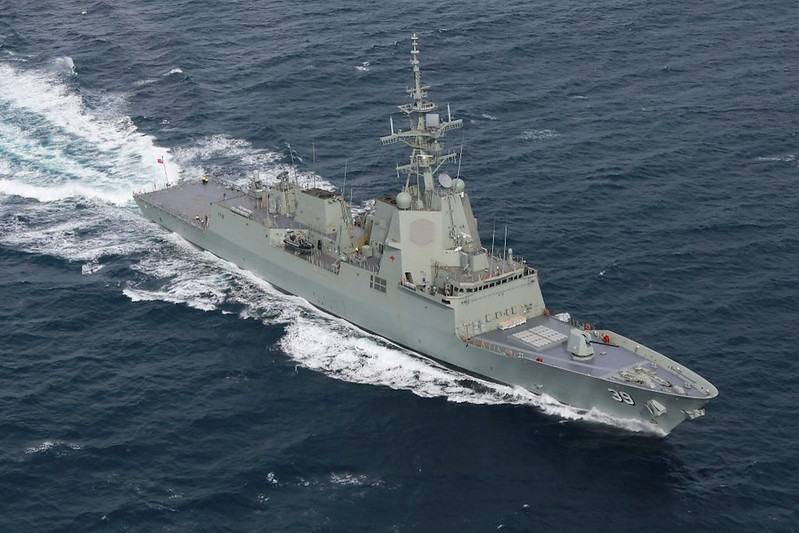
- Austal Independence class LCS derivitive
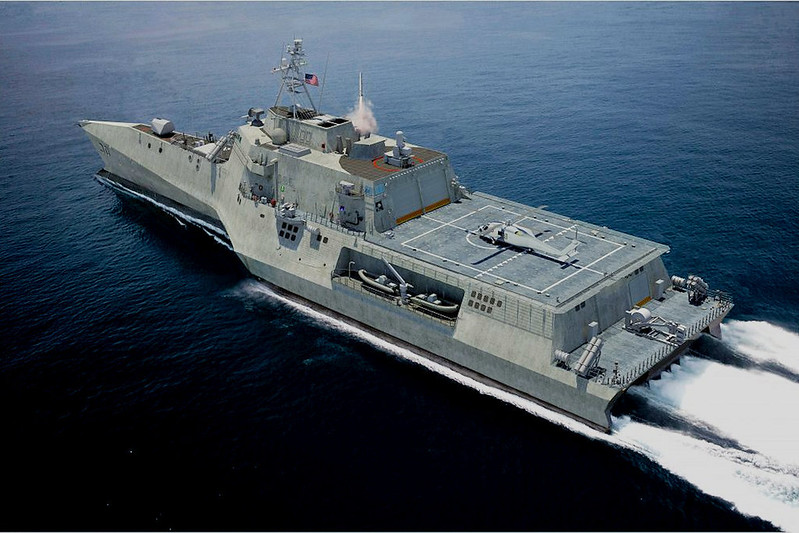
- Fincantieri Marine Italian FREMM frigate derivitive
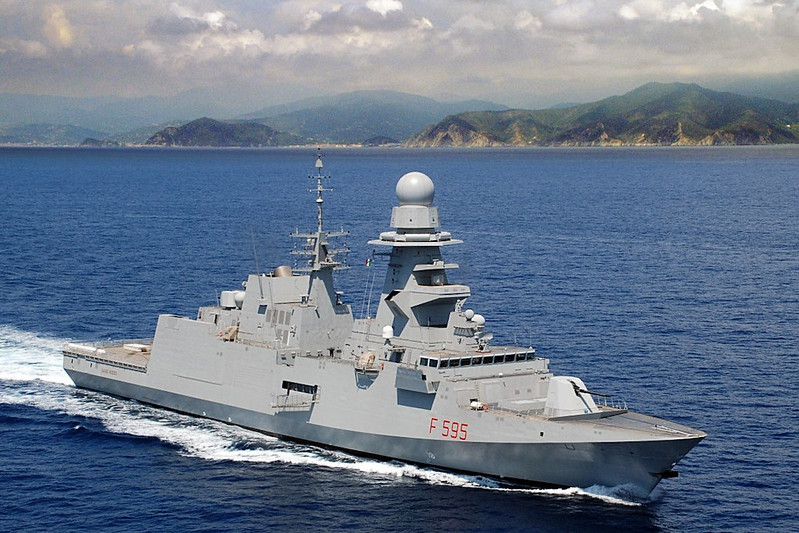
- Lockheed Martin heavily upgraded Freedom class derivitive
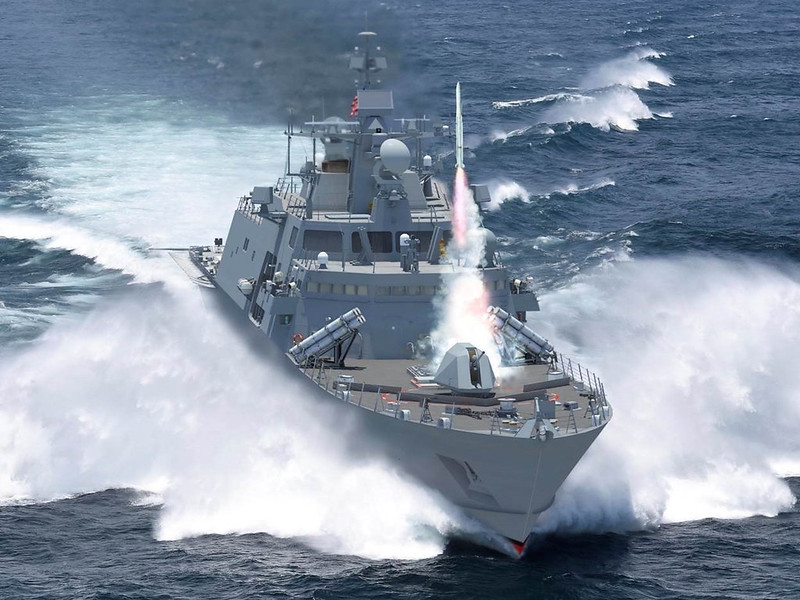
- Huntington Ingalls Legend Class Coast Guard cutter derivitive
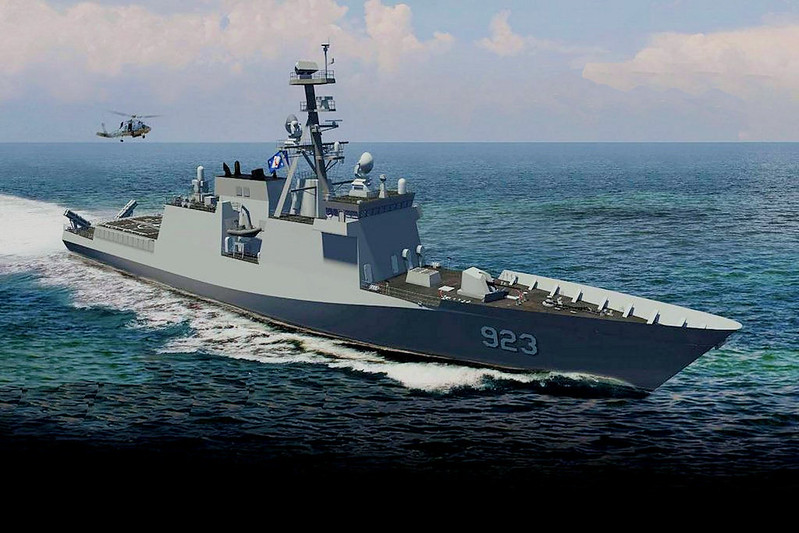
All of these are fine vessels, especia;l;y te F-100, which is also the Hobart DDG fro the Australians. I just do nmot think they will be able to get that vessel in at the correct price point with 48 Mk-41, a 5" gun, etc.
Also, based on my own experience, and particularly with the current administration pushing a "Make America Strong again," and American economic basis for what is already turning around the US economy significantly, I do not believe a foreign design will win, which IMHO, leaves out both the Italian and Spanish designs.
Although the Austal design shows 16 OTH missiles, and the same 16 cell Mk-41 VLS, the Austral design is still heavily aluminum and much more susceptible to damage, and has not received as strong a reception as the Freedom class LCS in the US Navy to date, and Lockheed Martin is heavily involved in setting up many of the electronics for all of the vessels and has shown over decades its ability to do so. The Huntington Ingalls class would be a good design as well...but it is a more 1980s-1990s type hull and superstructure configuration with very little of the stealth features, and although HI has built many very strong Amphibious ships for the US Navy, in terms of service contracts, and they have built a great US Coast Guard cutter (eight out of eleven so far), they are just not strongly considered in the environment of a major US Navu surface combatant.
That is why I believe the Lockheed design has the strongest chance, and will, I believe win the competition.
History iof the Littoral Combat ship (LCS) Design:
In order to fully understand this competition you have to understand the history of the LIttoral Combat Ship (LCS) experience the US Nay has had over the last ten years (which has been sophomoric at best and very embarrassing in any case).
What started as a competition to produce a very fast, very modular frigate sized vessel and a competition between two contenders, Lockheed with a mono-steel hulled vessel and the Trimaran, Aluminum vessel from Austral, under the Obama administration went far awry.
What was supposed to be the capability of replacing modules to give the vessels the ability to change from anti-surface, to anti-submarine, to counter-mine, and other capabilities within a 24-36 hour period, came apart at the seems, with it requiring several days to a week to make the change, and several modules that simply were not working. In addition to that, it was decided to produce both vessels to build up the 56 vessels desired (meaning 28 of each). Finally, the vessels themselves in any configuration, including the anti-surface warfare module, were incapable of defending themselves or having a hope to win in a confrontation between any peer nation frigate, or even their corvettes.
The light sensor package, the lack of any long range, over the horizon missiles, the light combat build/construction, and the very small crews which in any major damage would be too small to handle war fighting and damage control, made this unavoidable.
In order to address this the US Navy ultimately, despite the Obama administration attempts to slow down or derail the efforts, produced requirements and changes to cut the overall number of vessels and round the rest out with a Fast Frigate (FF) design that would require an upgrade of sensors, armor, and weapons to allow at least 20 vessels to have the necessary sensors and armament to make them competitive, and to be able to back fit these upgrades to vessels already built..
Finally, after the elections in 2016, the ultimate requirement produced a need to cut the overall LCS production to 24, adding 16 FF vessels for a total of 40, with the ability to upgrade already produced LCS vessels to the FF standard. This standard basically added a SeaRAM defensive anti-air system, added over the horizon missiles to augment 24 hellfire misiles, added some sensor upgrades, and some additional armor. This helps a lot, but would not make the vessels able to really take on peer nation frigates all to well.
What is depicted in this album is the next true guided missile frigate of the US Navy, the FFG(X) program and the vessel I believe most likely to win the competition. I produced a model in 1/350 scale to depict this.
Right now you have Lockheed developing a significantly upgunned and upgraded sensor and armored version of the Freedom LCS class, Austal with a similar upgrade to the Independence class, the Italian firm, Fincantieri Marine Group, with a suitably altered version of r their FREMM frigate, General Dynamics, with a version of the Spanish F-100 AEGIS vessel, and Huntington Ingalls Industries with Frigate version of the Legend class National Security, or Legend Class US Coast Guard Cutters.
Again, here are the Five Entries, and a decision will be made in 2019, with the first FFG starting construction in 2020 and the second in 2021:
- Bath Iron Works, Spanish Navantia F100 AEGIS derivative
- Austral Independence class LCS derivative
- Fincantieri Marine Italian FREMM frigate derivative
- Lockheed Martin heavily upgraded Freedom class derivative
- Huntington Ingalls Legend Class Coast Guard cutter derivative
All of these are fine vessels, especially te F-100, which is also the Hobart DDG fro the Australians. I just do not think they will be able to get that vessel in at the correct price point with 48 Mk-41, a 5" gun, etc.
Also, based on my own experience, and particularly with the current administration pushing a -Make America Strong again- and American economic basis for what is already turning around the US economy significantly, I do not believe a foreign design will win, which IMHO, leaves out both the Italian and Spanish designs.
Although the Austral design shows 16 OTH missiles, and the same 16 cell Mk-41 VLS, the Austral design is still heavily aluminum and much more susceptible to damage, and has not received as strong a reception as the Freedom class LCS in the US Navy to date, and Lockheed Martin is heavily involved in setting up many of the electronics for all of the vessels and has shown over decades its ability to do so. The Huntington Ingalls class would be a good design as well...but it is a more 1980s-1990s type hull and superstructure configuration with very little of the stealth features, and although HI has built many very strong Amphibious ships for the US Navy, in terms of service contracts, and they have built a great US Coast Guard cutter (eight out of eleven so far), they are just not strongly considered in the environment of a major US Navu surface combatant.
That is why I believe the Lockheed design has the strongest chance, and will, I believe win the competition.
In order to fully understand this competition you have to understand the history of the LIttoral Combat Ship (LCS) experience the US Nay has had over the last ten years (which has been sophomoric at best and very embarrassing in any case).
What started as a competition to produce a very fast, very modular frigate sized vessel and a competition between two contenders, Lockheed with a mono-steel hulled vessel and the Trimaran, Aluminum vessel from Austral, under the Obama administration went far awry.
What was supposed to be the capability of replacing modules to give the vessels the ability to change from anti-surface, to anti-submarine, to counter-mine, and other capabilities within a 24-36 hour period, came apart at the seems, with it requiring several days to a week to make the change, and several modules that simply were not working. In addition to that, it was decided to produce both vessels to build up the 56 vessels desired (meaning 28 of each). Finally, the vessels themselves in any configuration, including the anti-surface warfare module, were incapable of defending themselves or having a hope to win in a confrontation between any peer nation frigate, or even their corvettes.
The light sensor package, the lack of any long range, over the horizon missiles, the light combat build/construction, and the very small crews which in any major damage would be too small to handle war fighting and damage control, made this unavoidable.
In order to address this the US Navy ultimately, despite the Obama administration attempts to slow down or derail the efforts, produced requirements and changes to cut the overall number of vessels and round the rest out with a Fast Frigate (FF) design that would require an upgrade of sensors, armor, and weapons to allow at least 20 vessels to have the necessary sensors and armament to make them competitive, and to be able to back fit these upgrades to vessels already built..
Development of the FFG(X) Program
Finally, after the elections in 2016, the ultimate requirement produced a need to cut the overall LCS production to 24, adding 16 FF vessels for a total of 40, with the ability to upgrade already produced LCS vessels to the FF standard. This standard basically added a SeaRAM defensive anti-air system, added over the horizon missiles to augment 24 hellfire missiles, added some sensor upgrades, and some additional armor. This helps a lot, but would not make the vessels able to really take on peer nation frigates all to well.
In order to do that, a competition for this new FFG(X) was introduced to replace the remaining 16-17 vessels originally envisioned with a 20 ship strong class of FFGs (called FFG(X) with the competition between the contenders named above. If the current administration holds office after 2020, it is my surmise that more than 20 of these vessels may be built...and that would be a good thing.
The new vessel would be fully FFG capable, would be larger, would not be modular but would be multi-mission requiring the produced vessels to be able to be able to perform anti-surface warfare, anti-submarine-warfare, and anti-air warfare at the same time, with a medium ranged (out to 45-50 miles) anti-air capability, which the LCS and has been removed from the FF.
So, as I say, I believe the US is most likely to pick the Lockheed Martin design. Lockheed has the most experience and is in the best position to produce a vessel that will be able to communicate with the rest of the US Fleet, particularly the AEGIS class destroyers and cruisers for cooperative engagement, and most capable to produce a fully combat worthy, strong guided missile frigate with the flexibility and armament necessary for the US Navy needs into the 2040s and 2050s.
So, getting to the new frigate I purchased from Dutch Naval Miniatures online at Shapeways 3D, the load-out I am showing on this model in 1/350 scale includes:
Displacement: 4,000-4,500 tons
Lengeth: 410 Ft (125m)
Width: 60 ft (18.5m)
Range: 8,000-10,000 nautical miles
Compliment: 130+ personnel
Speed 32+knts
Sensors:
- COMBATSS-21 Combat Management System (which will be an AEGIS derivative capable of working with full AEGIS vessels in a cooperative engagement capability:
- Enterprise Air Surveillance Radar (EASR)[1]
- Next Generation Surface Search Radar
- AN/SLQ-61 light weight towed array sonar
- AN/SQS-62 Variable-Depth Sonar
- AN/SQQ-89F undersea warfare/anti-submarine warfare combat system
Armament:
- 1 x 57mm main gun - 16 Mk-41 VLS cells using RIM-1
62 ESSM Block 2 (Quad Pack), RIM-174 ERAM (SM6), or AGM-158C LRASM missiles
(Suggested loadut would be ASuW: 4 x LRASM, 64 x ESSM, or AAW: 8 x ERAM (SM6) 32 x ESSM
- 8 Over the Horizon misiles in 2xquad cannister packages
- 1 x SeaRAM Mk15 Mod 31 short range anti-air defense system
- 24 Hellfire missiles in VLS cells
- 1 x mature, fully capable Laser Weapons System (LAWS)
- 2 x 30mm secondary guns
Air Facilities:
- One Hanger
- One MH-60R helicopter
- 1 Fire Scout UVAV unmanned vertcal helo
As I say, the basic model was produced by Dutch Fleet Miniature 3D Models from Shapeways. I then purchased two Trumpeter LCS Freedom class, USS Ft-worth 1/350 scale models, as well as well as 1/350 scale Veteran Models SeaRAM and Harpoon quad launchers in 1/350 scale. As well as several other 1/350 scale parts from 3rd parties and/or spare parts from other US Navy models in 1/350 scale. The idea was to take off the less detailed parts from the Dutch model vessel and add the more detailed parts available from the Trumpeter models (many LCS parts are compatible) and from the other sources. I used photo etch metal parts for railing and various sensors and other parts from the Trumpeter models and other spare parts.
In the end, what you see is what was produced, starting with the initial concept pictures of the FFG(X) from Lockheed, progressing through the Dutch Naval Miniature model as I received it, and then showing the various other components and progressing through their builing onto the ship and culminating in the finished model. Finally comparing the new FFG(X) to an up gunned LCS to the new FF standard for LCS-3 USS Ft. Worth, which would at that point be re-designated to FF-3.
Hope you enjoy the thread. My intent is to produce two of these vessels so that I can add them to my US Carrier Strike Group and/or my US Navy Amphibious Ready Group in 1/350 scale. See the following videos in my Youtube channel, and the build thread on Sino-Defense forum:
US Navy two carrier Strike group in 1/350 scale:
www.youtube.com/watch?v=2EfoVwP4Kp0
US Navy Amphibious Ready Group in 1/350 scale
www.youtube.com/watch?v=fs0pJvCq7eg
US Navy USS Ronald Reagan, CVN-76, Nimitz class carrier in 1/350 scale
www.youtube.com/watch?v=ESlQidhdXT0
US Navy USS Enterprise, CVN-80 Ford class carrier in 1/350 scale:
www.youtube.com/watch?v=q04Hy8CQjC8
Sino-Defense Build Thread:
www.sinodefenceforum.com/new-us-navy-ffg-x-and-1-350-mode...
Similar Damage/mismanagement of the Zumwlt Class
BTW, for those interested, the Obama administrations actions with the Zumwalt class destroyers was even more telling. What could have been...and hopefully ultimately will ultimately result in a CG(X) offering, was so mis-managed and derailed to produce 3 ships with a main gun that is on the ships, but has absolutely nothing to fire. The very expensive and long range 155mm gun, that was supposed to support Marines ashore, inland to 100 miles and with several batteries worth of striking power, since they reduced the number of ships to only three, was cancelled due to cost. (With only three ships, instead of 30, the cost per round for the number of rounds they would purchase, exploded to 800,000 per round. So they cancelled it and left nothing that could shoot from the gun! The intended follow-on rail gun, which was supposed o test at sea in 2016, was set back, and then the test cancelled, and so now they have no plans to do so.
Hopefully, the new administration will correct these glaring errors and mismanagement, and select thie Zumwalt hull for the CGX and get more peripheral VLS cells on the vessel, the newer larger AEGIS APARs, and then the rail gun and laser weapons systems to make the vessel the modern marvel it was meant to be and could have and should have been.
Building the FFG(X) by Lockheed Martin in 1/350 scale:
So, moving along, the first thing I did as to buy the FFG(X) 1/350 scale model as a 3D print from Dutch Naval Miniatures on Shapeways 3D Print site, and the veteran detailed models for various parts, as well as two Trumpeter 1/350 LCS USS Ft. Worth LCS-3 Freedom class models by Lockheed. I found a good deal on ebay for them for 14.99 each.
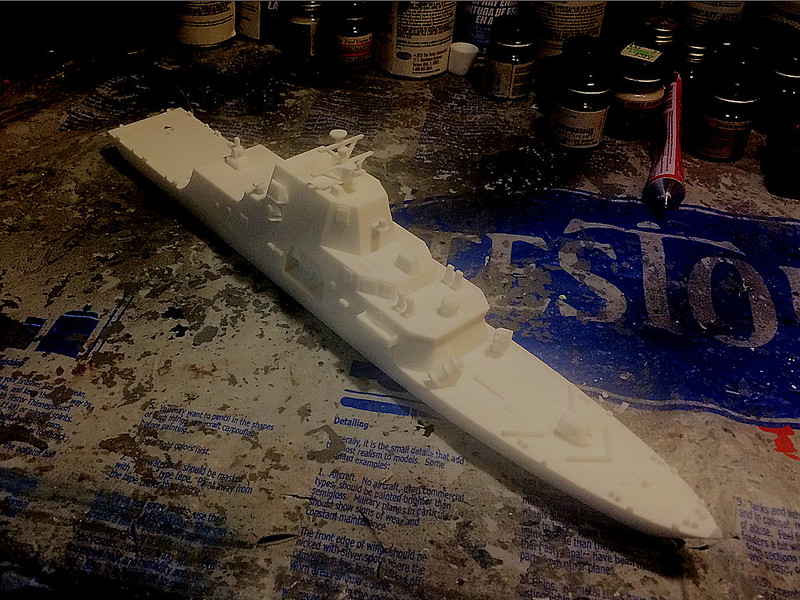
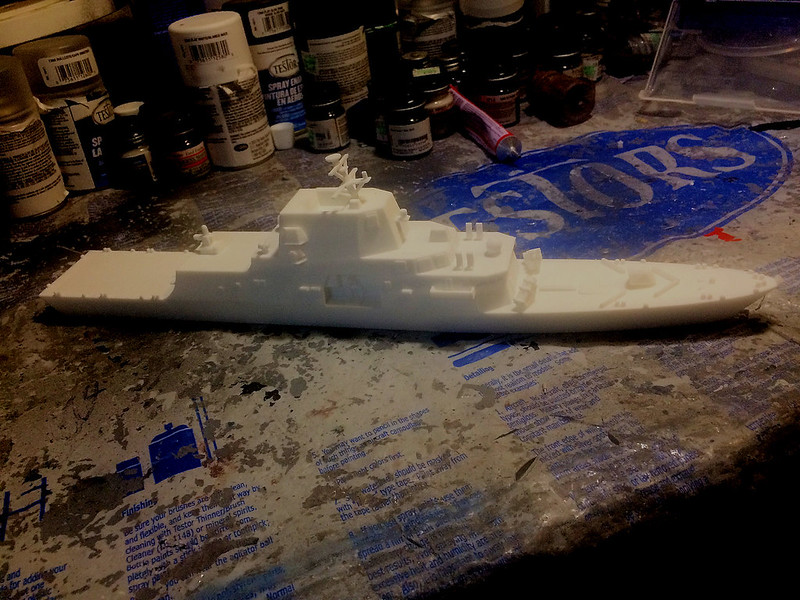
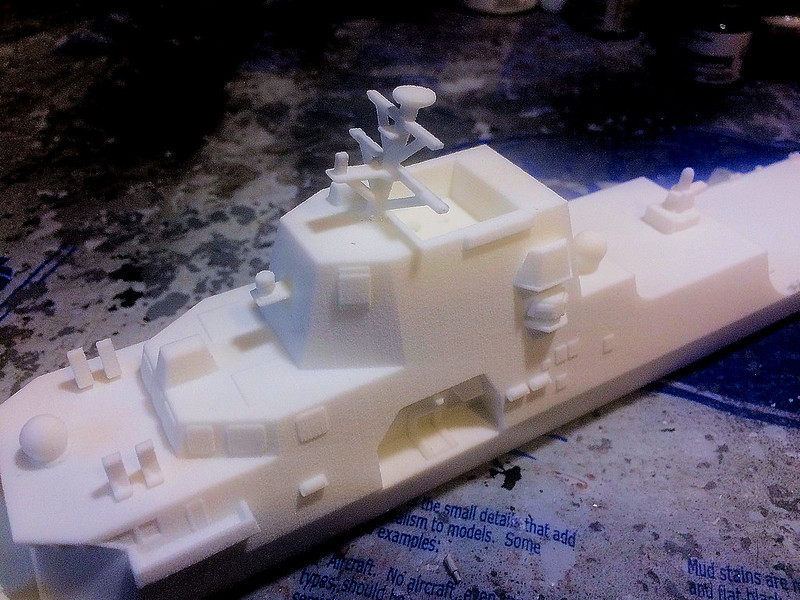
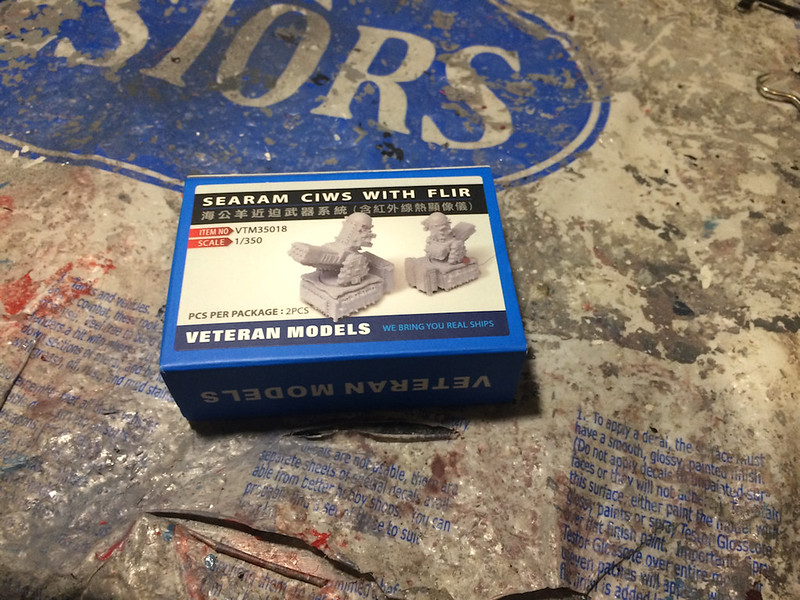
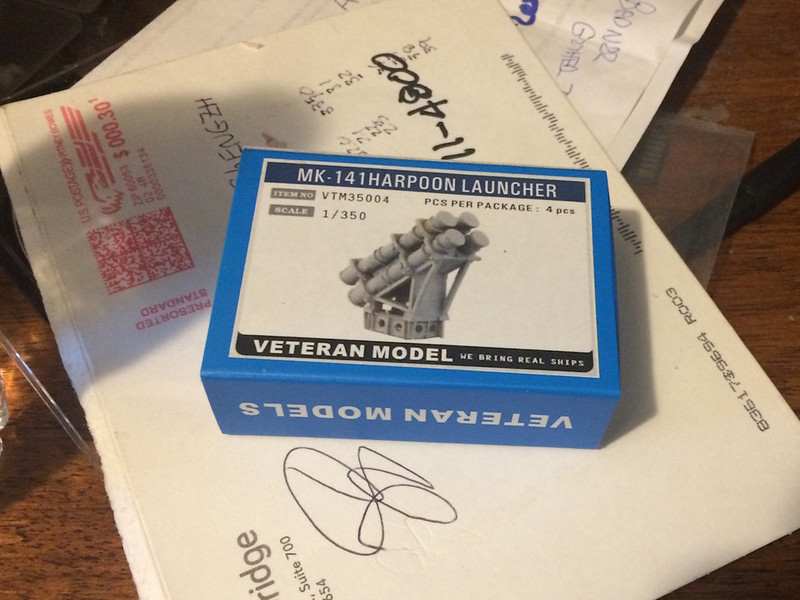
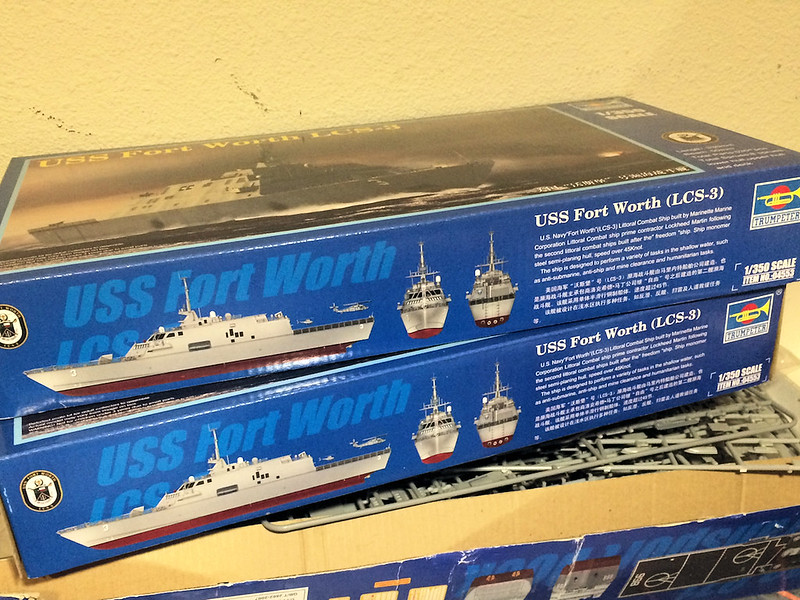
Then it was time to remove the non-detailed enough portions of the 3D model (like the main gun, the quad pack missile launchers, and the SeaRAM launcher), and then build some of the parts, paint some of the photo etch from the Trumpeter models and other spare parts I had. I then assembled some of these parts, did an initial paint on the D model, and then placed the parts, particularly on the after portion above and forward of the hanger.
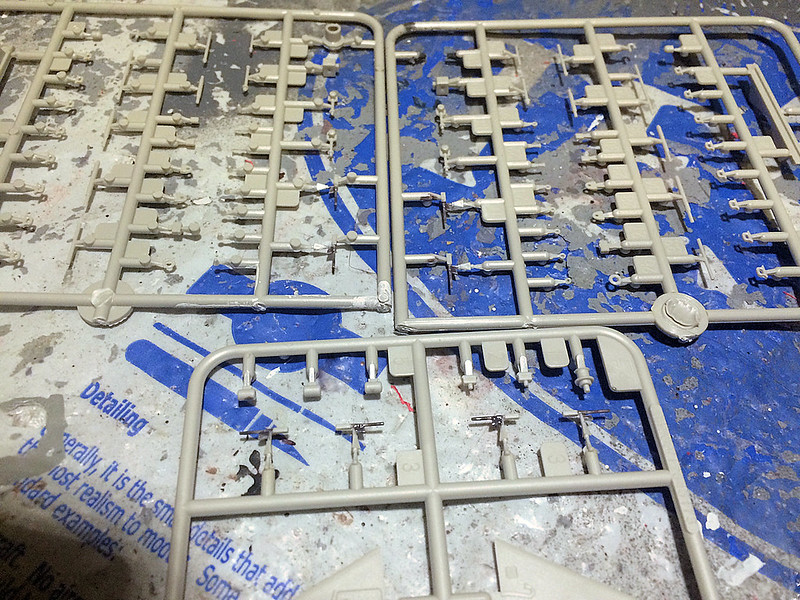
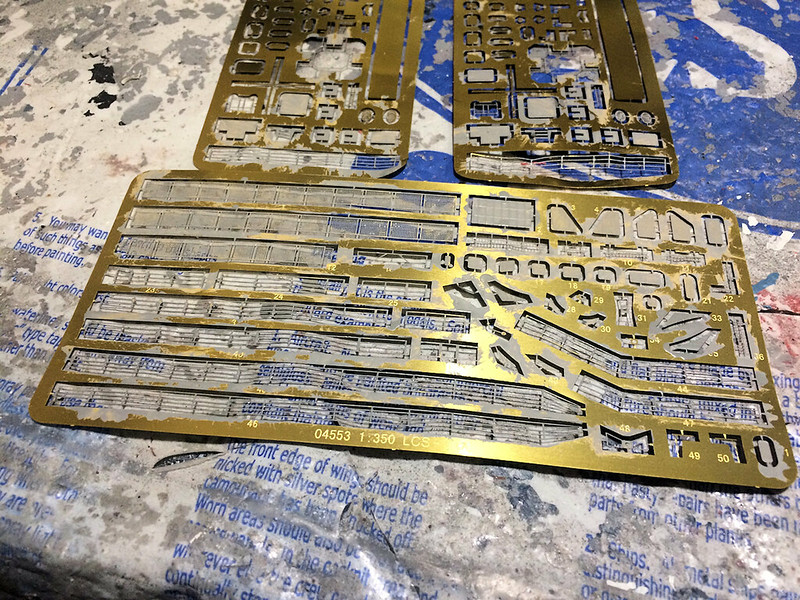
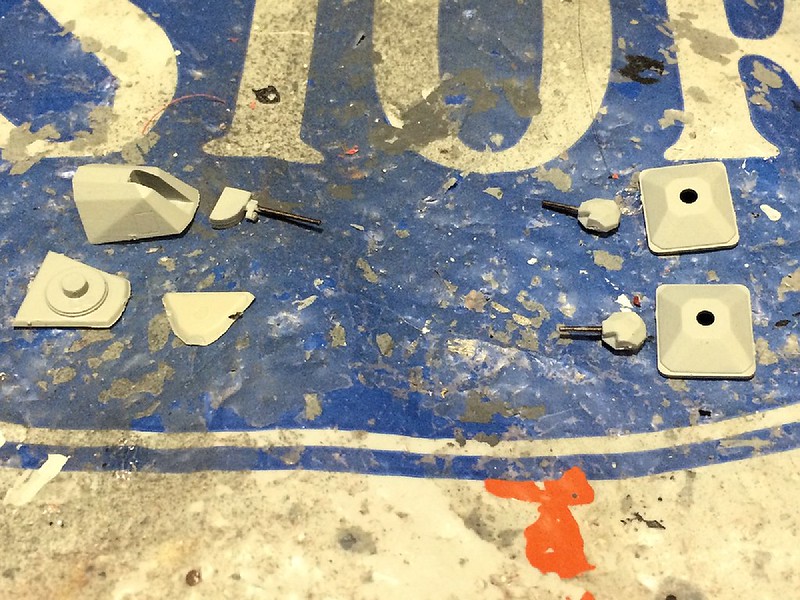
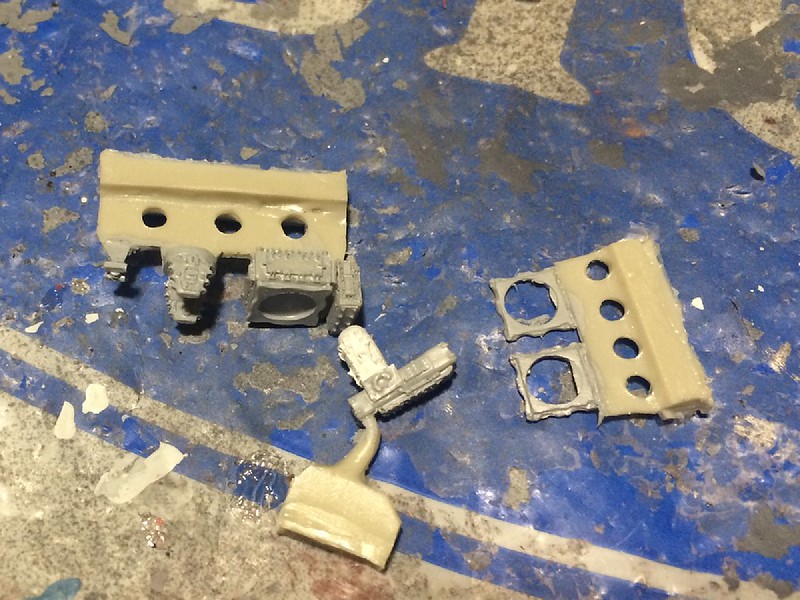
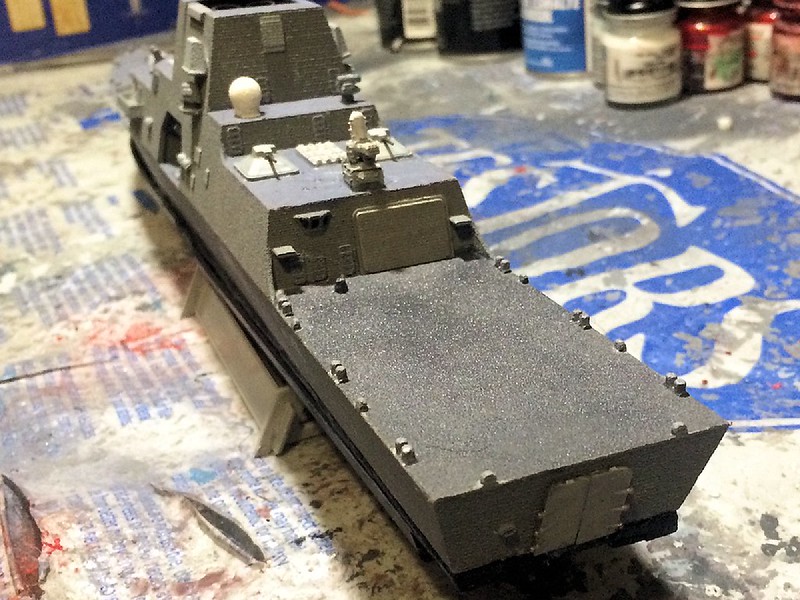
I then added the 57mm main gun forward, the smoke stacks hidded in the superstructure to reduce the IR signature of the ship, and then add more detailed printing of the various, existing sensors, radars panels, domes, etc. already on the ship. You can see that the quad launchers are missing on these last two pics. They will be added back later.
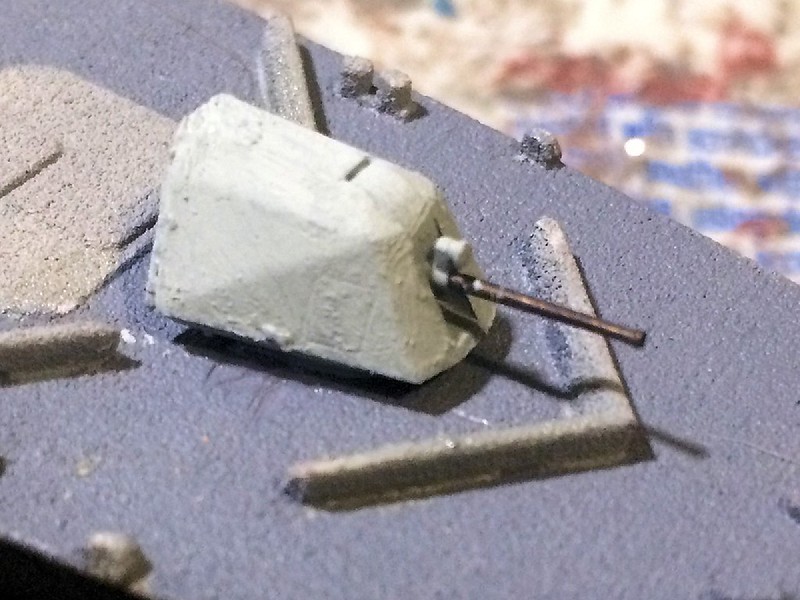
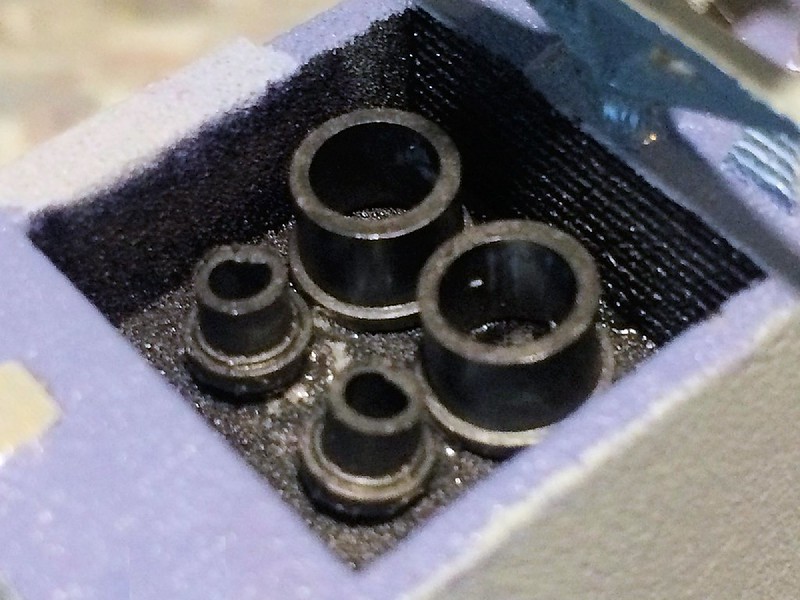
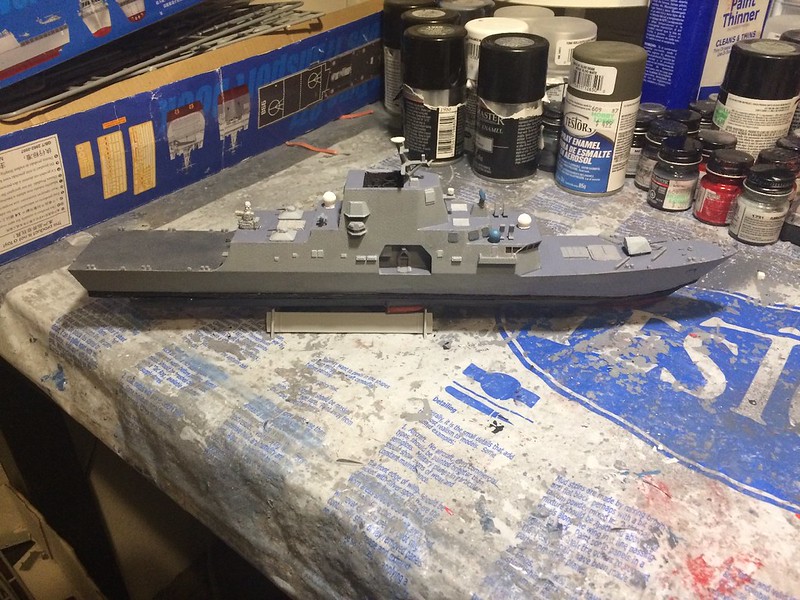
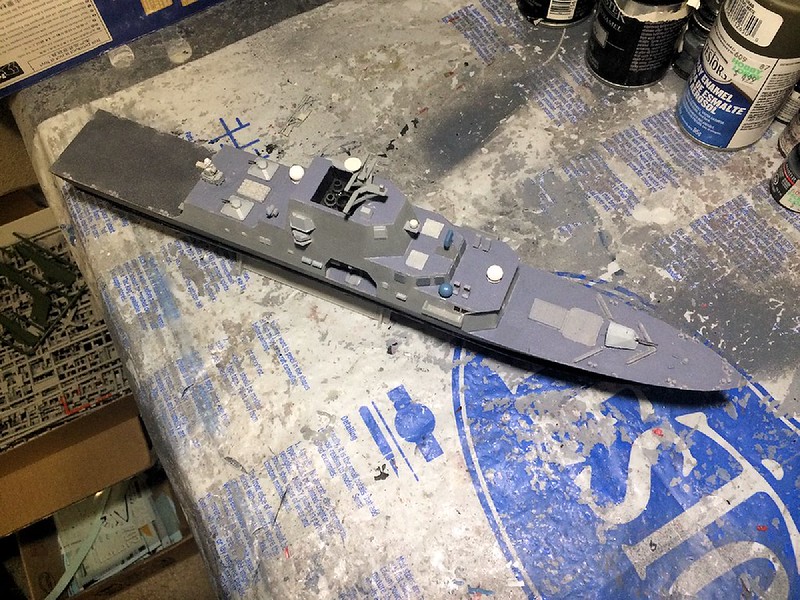
I then added details and photo etch railing. Details like .50 cal machine gns, spot lights, ladders, life buoys, antennae, etc. I then build the MH-60R helicopter and added the decals to the landing deck and then added the helo there on the landing deck.
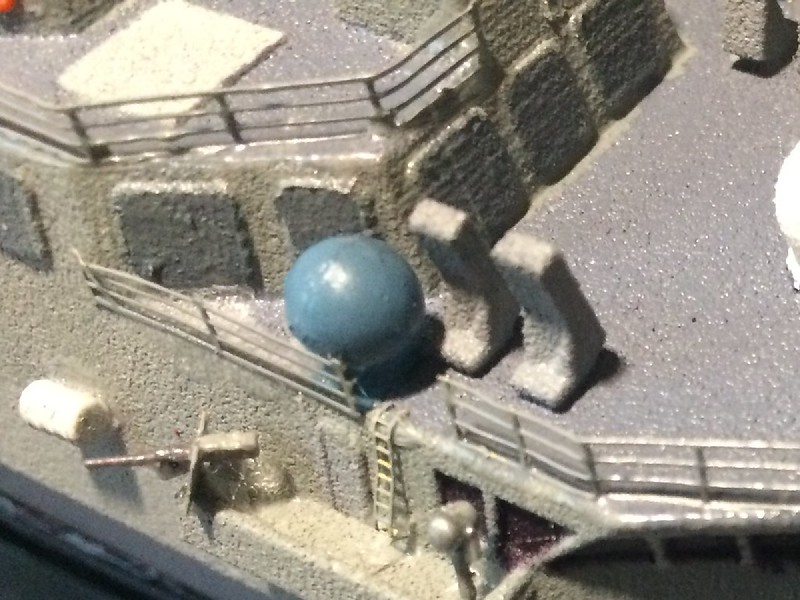
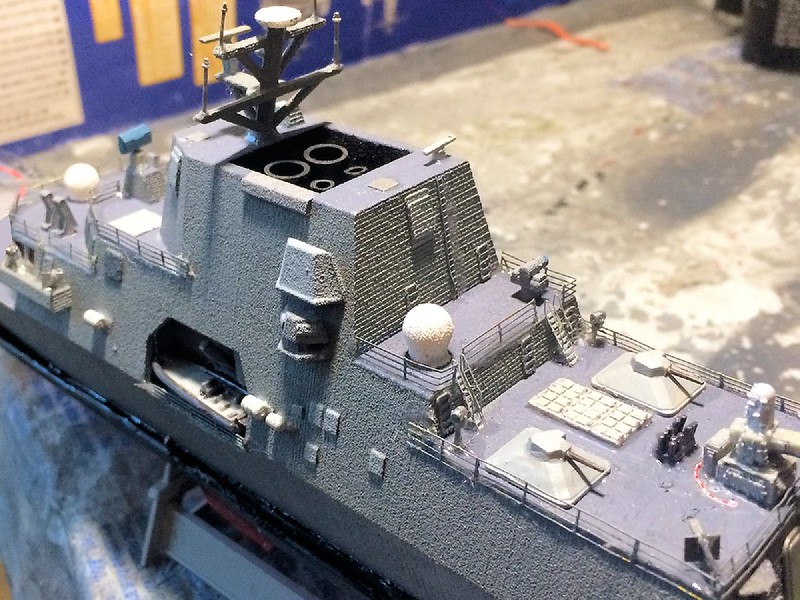
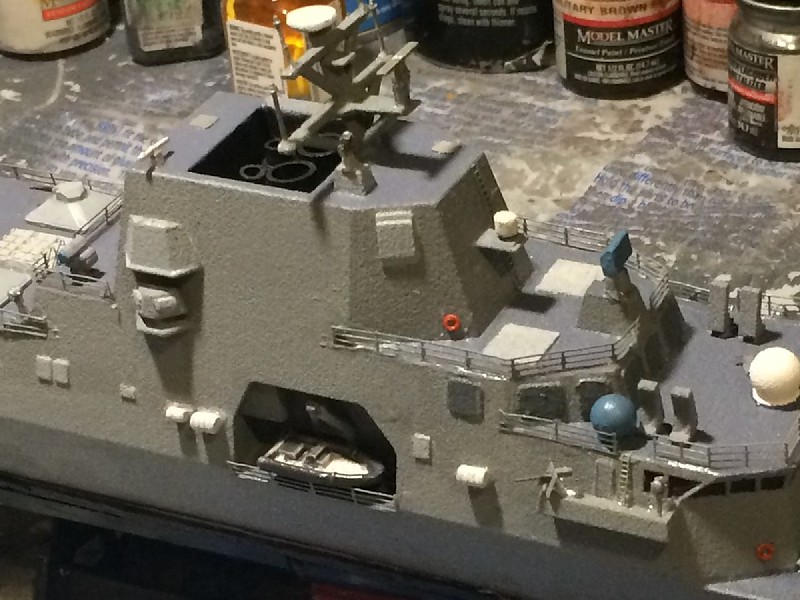
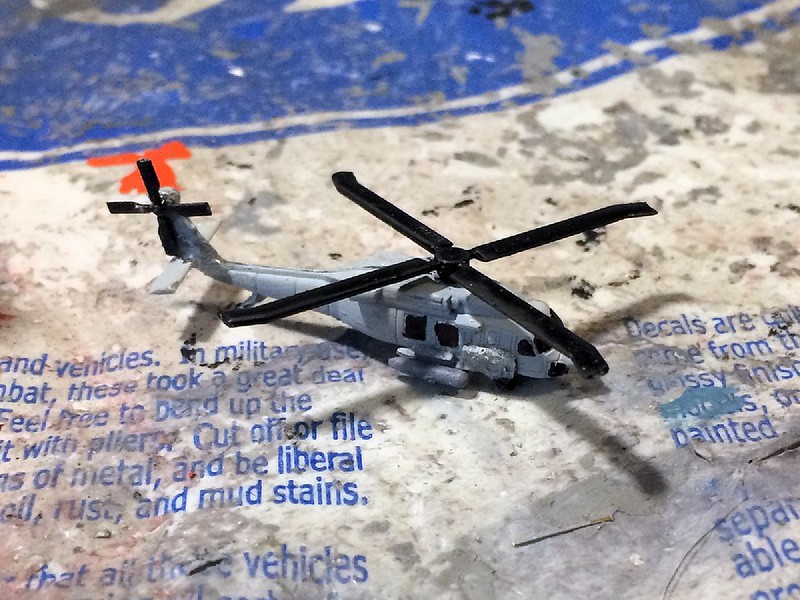
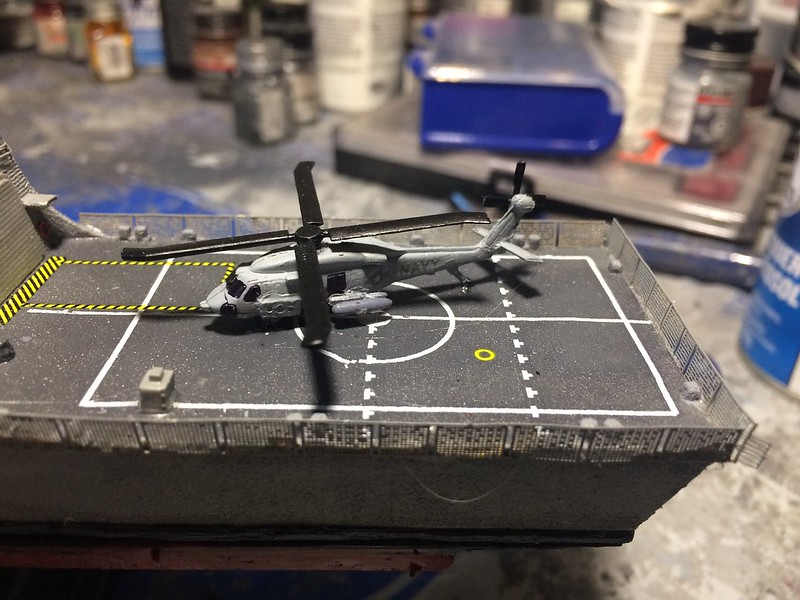
Now it was time to build the Veteran Harpoon missile quad lauchers and add them to the vessel, and then build and add the ships launches, and then add more sensors, equipment, etc. around the vessel. This included warning decals for the main gun and SeaRam.
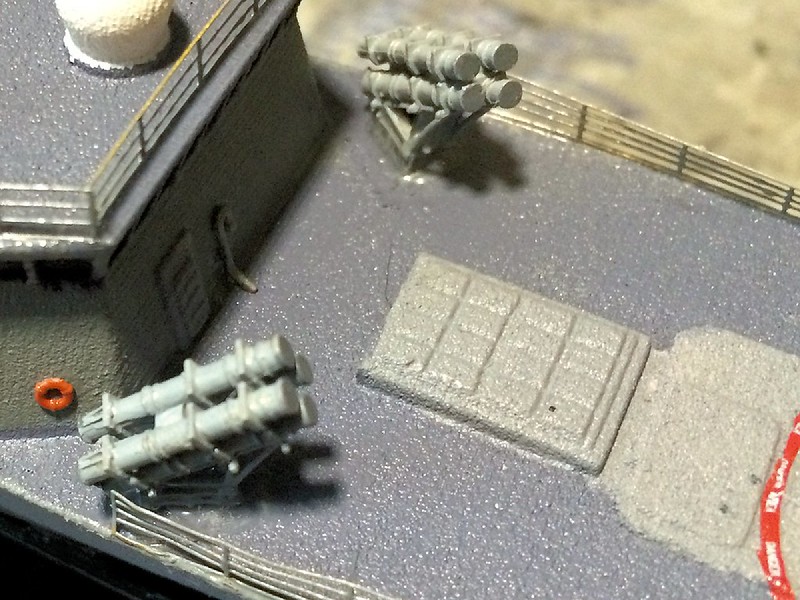
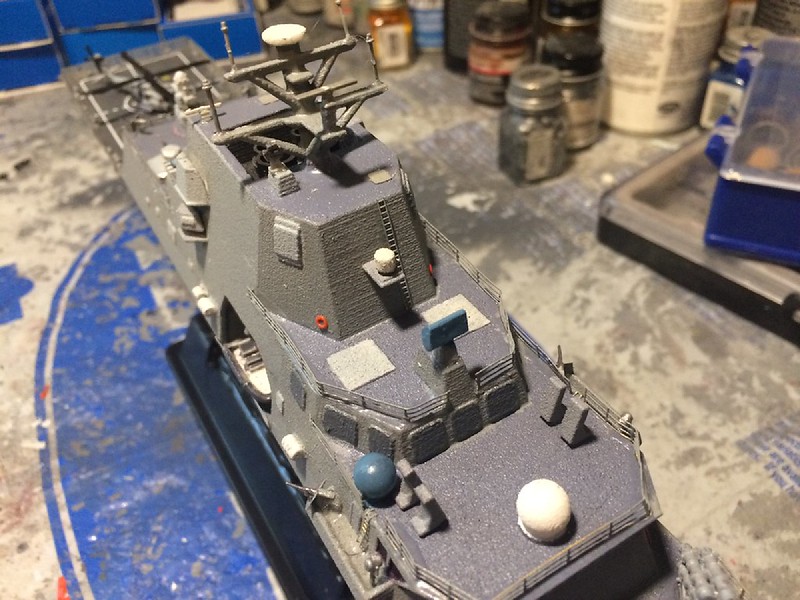
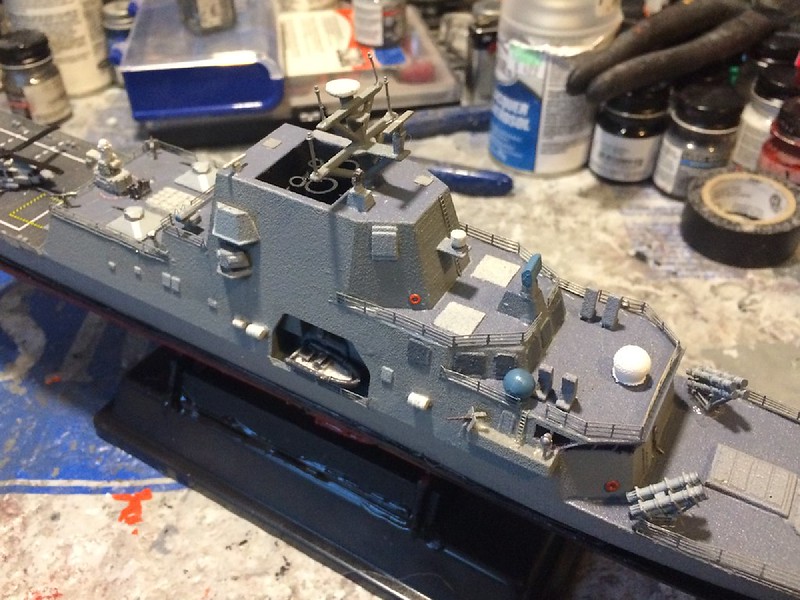
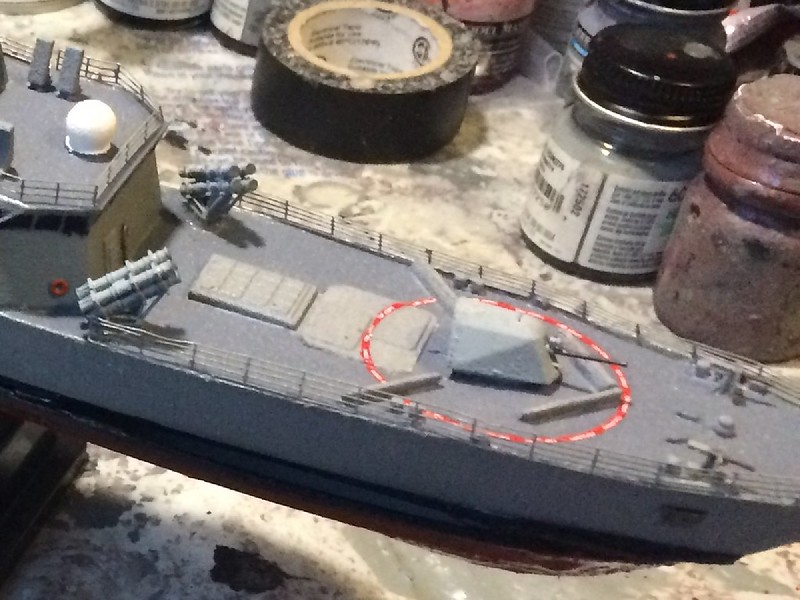
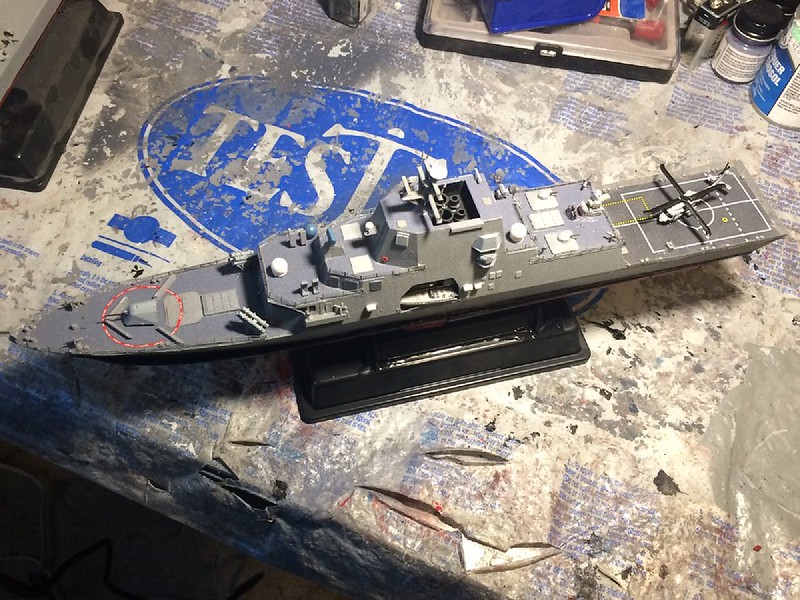
I then began detailing the lower hull and preparing it for fill where necessary and to prepare the waterline mark, adding the water jet propulsion units, while continuing to add detail in the superstructure and bridge areas around the vessel. I then added the fill and smoothed and painted the waterline mark on the lower hull
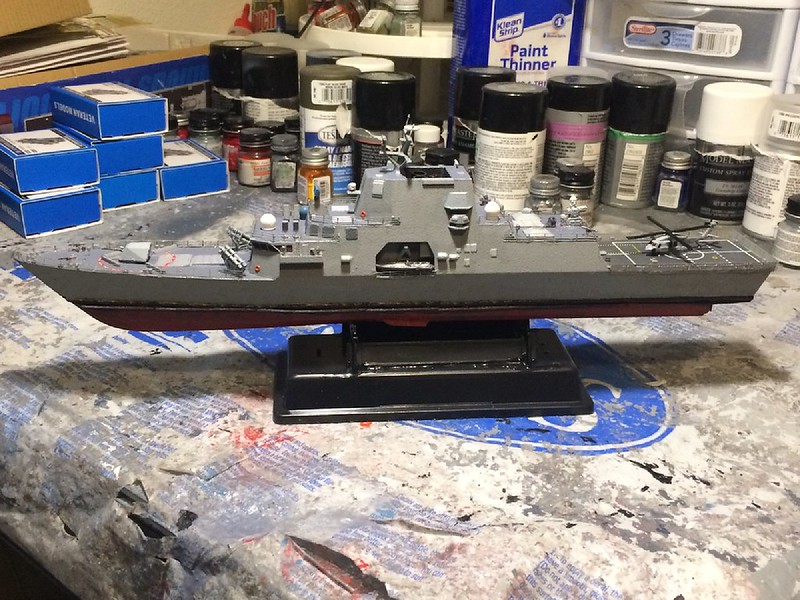
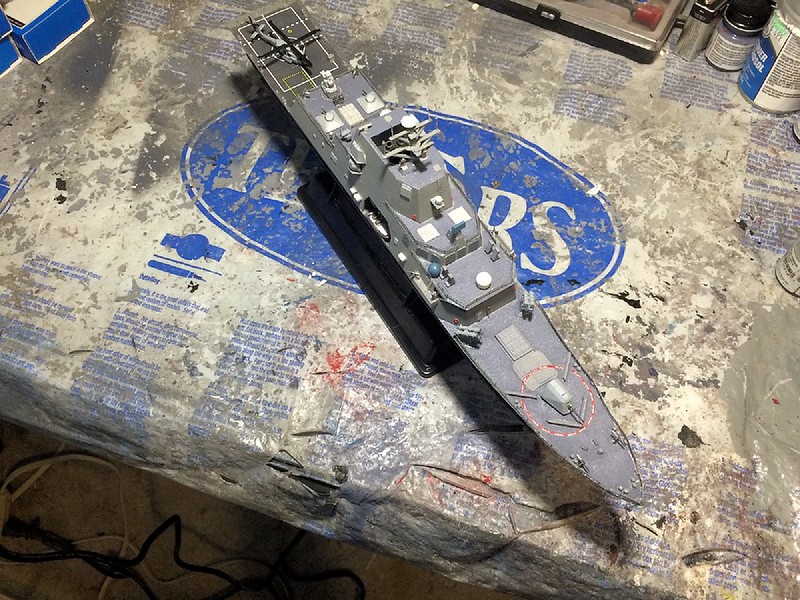
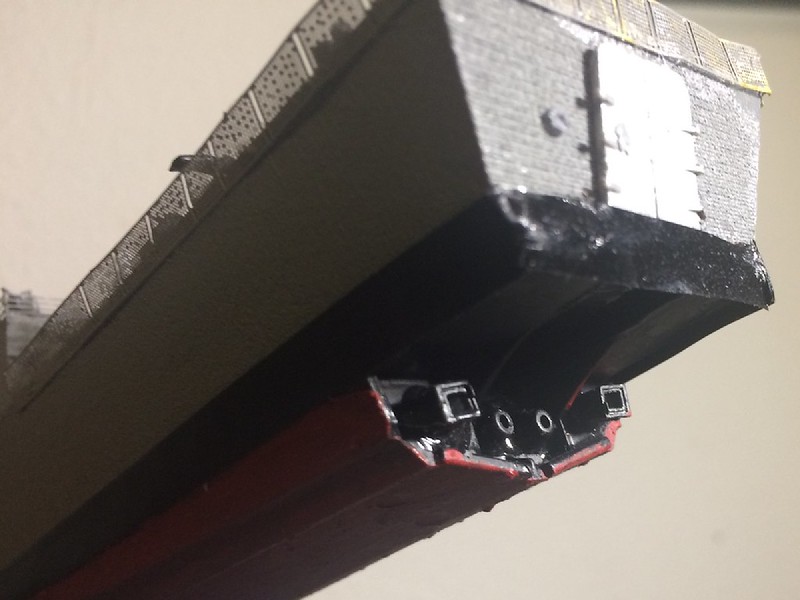
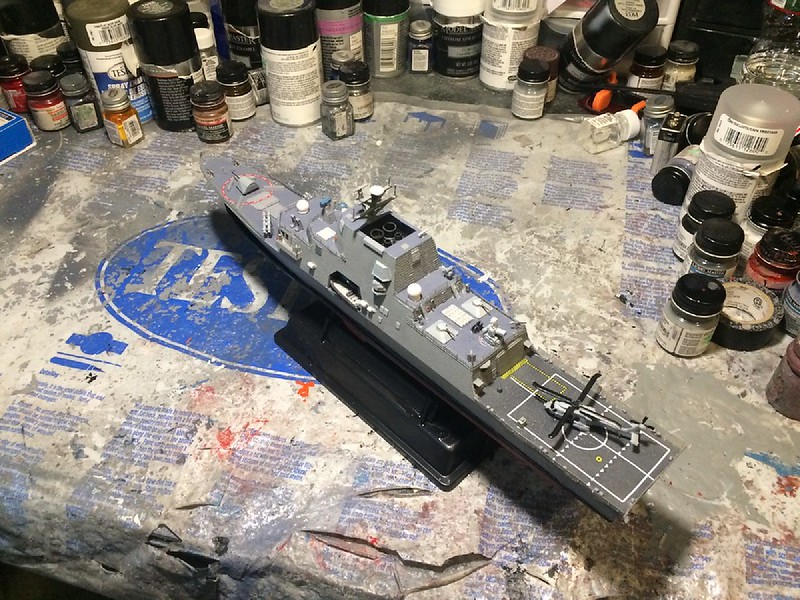
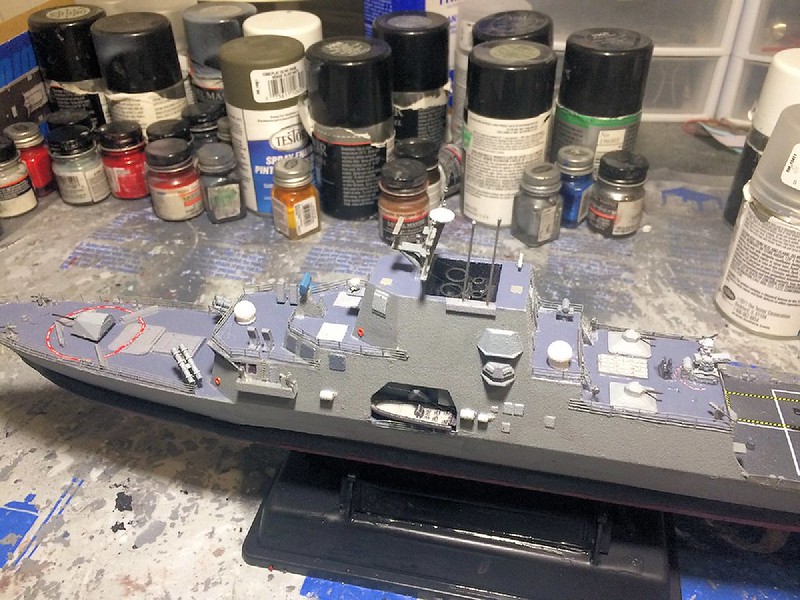
At this point it wat time for touch up the paint work, add the final details, and then add the two coats of flat clear paint to prepare for the final build pictures and then to add the final build pictures of the vessel. First the pictures from the eight position all aroun the ship includign the four quarters, fore and aft, and starboard and port. I will also show some close up detail pictures and some comparisons gainst an upgraded LCS to the FF standard. (All of these will be higher resolution pictures)
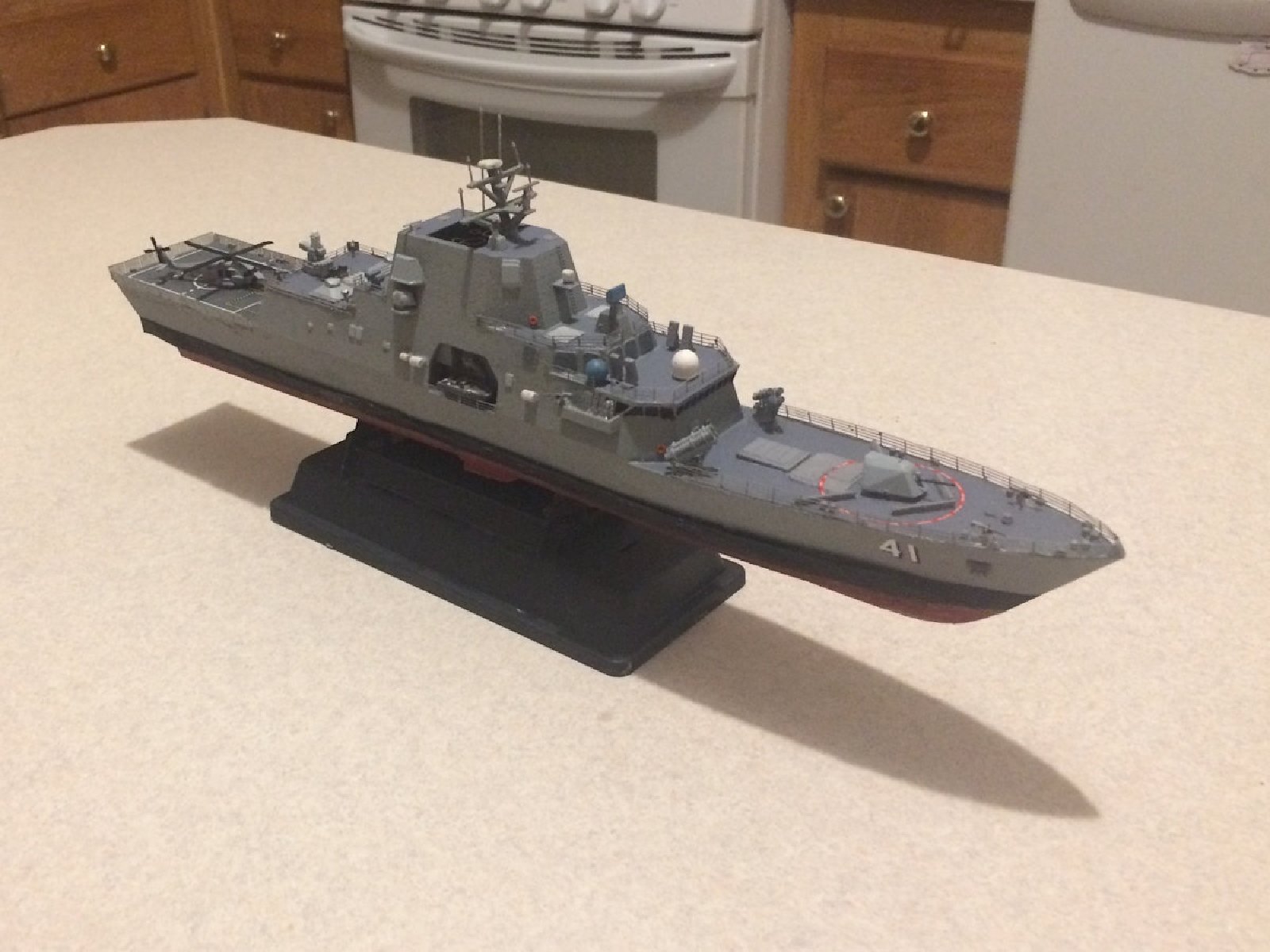
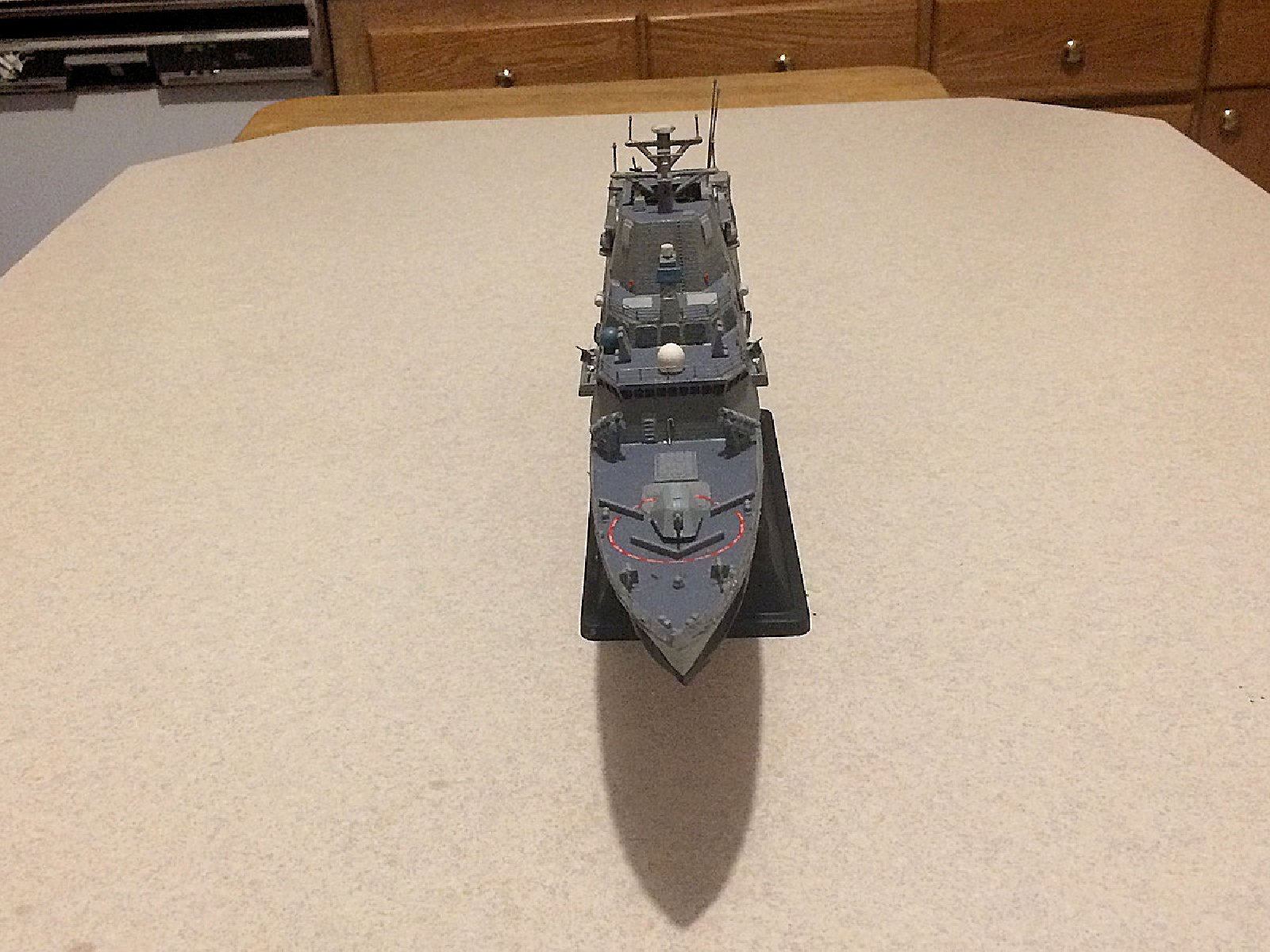
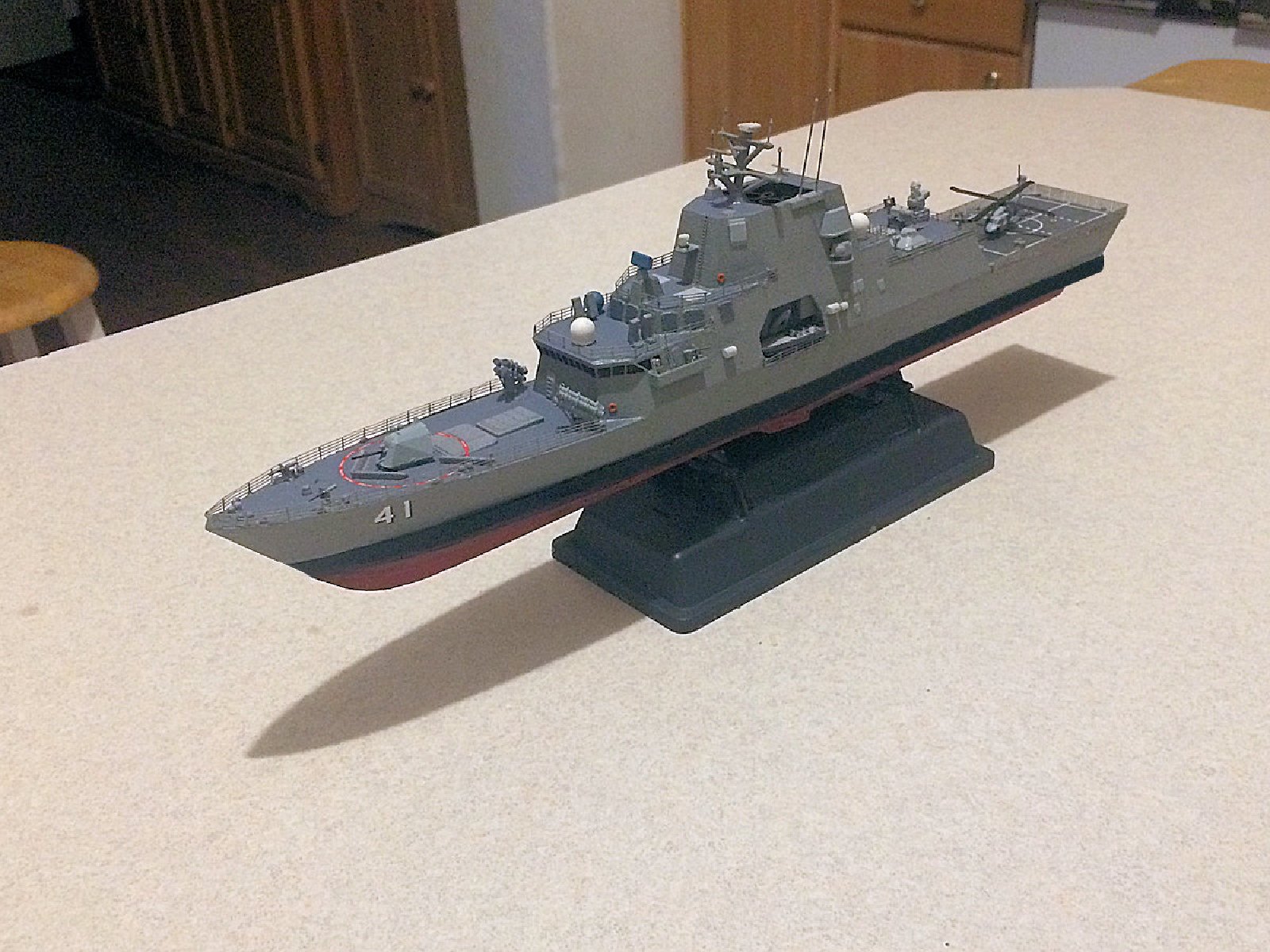
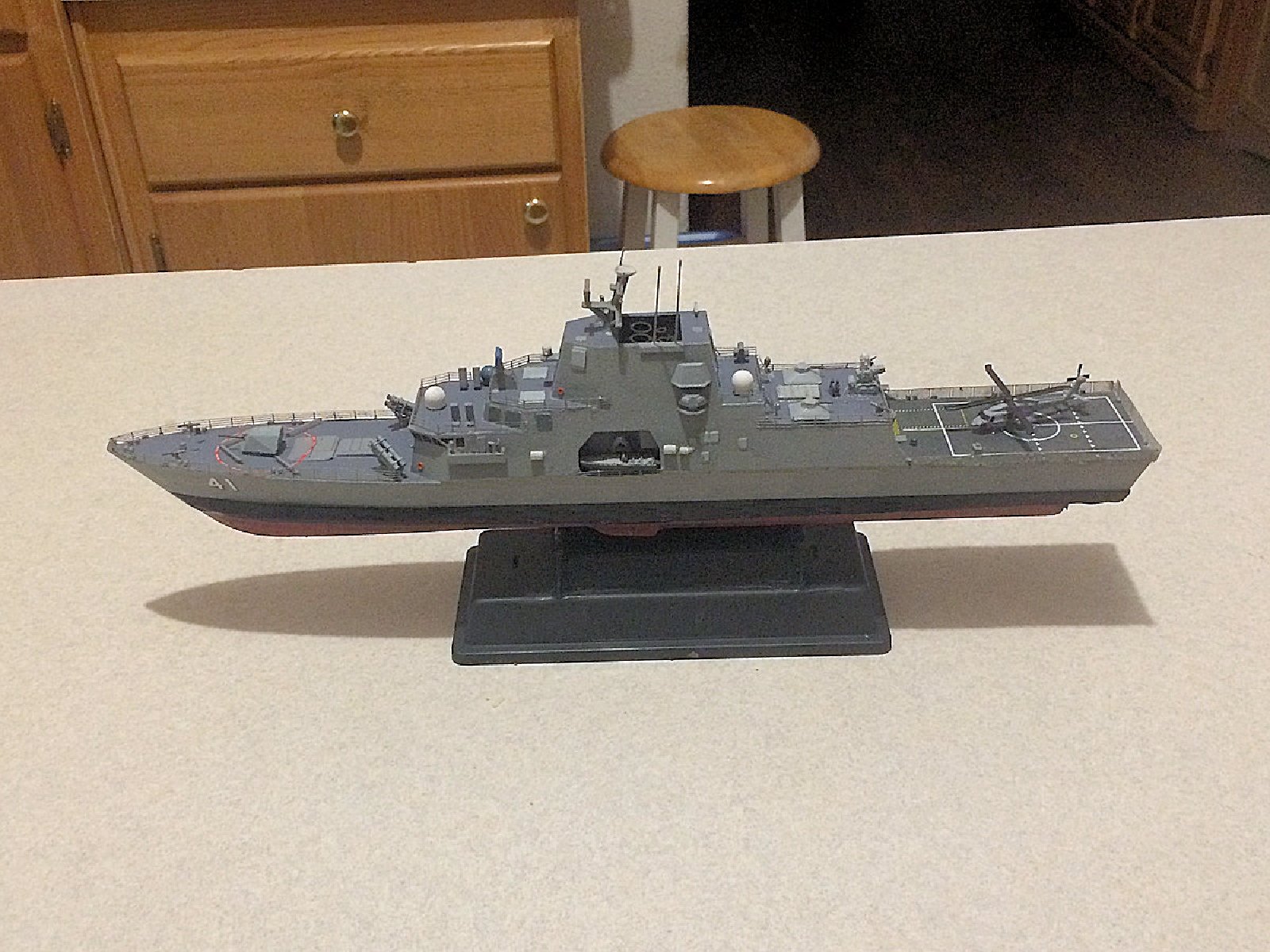
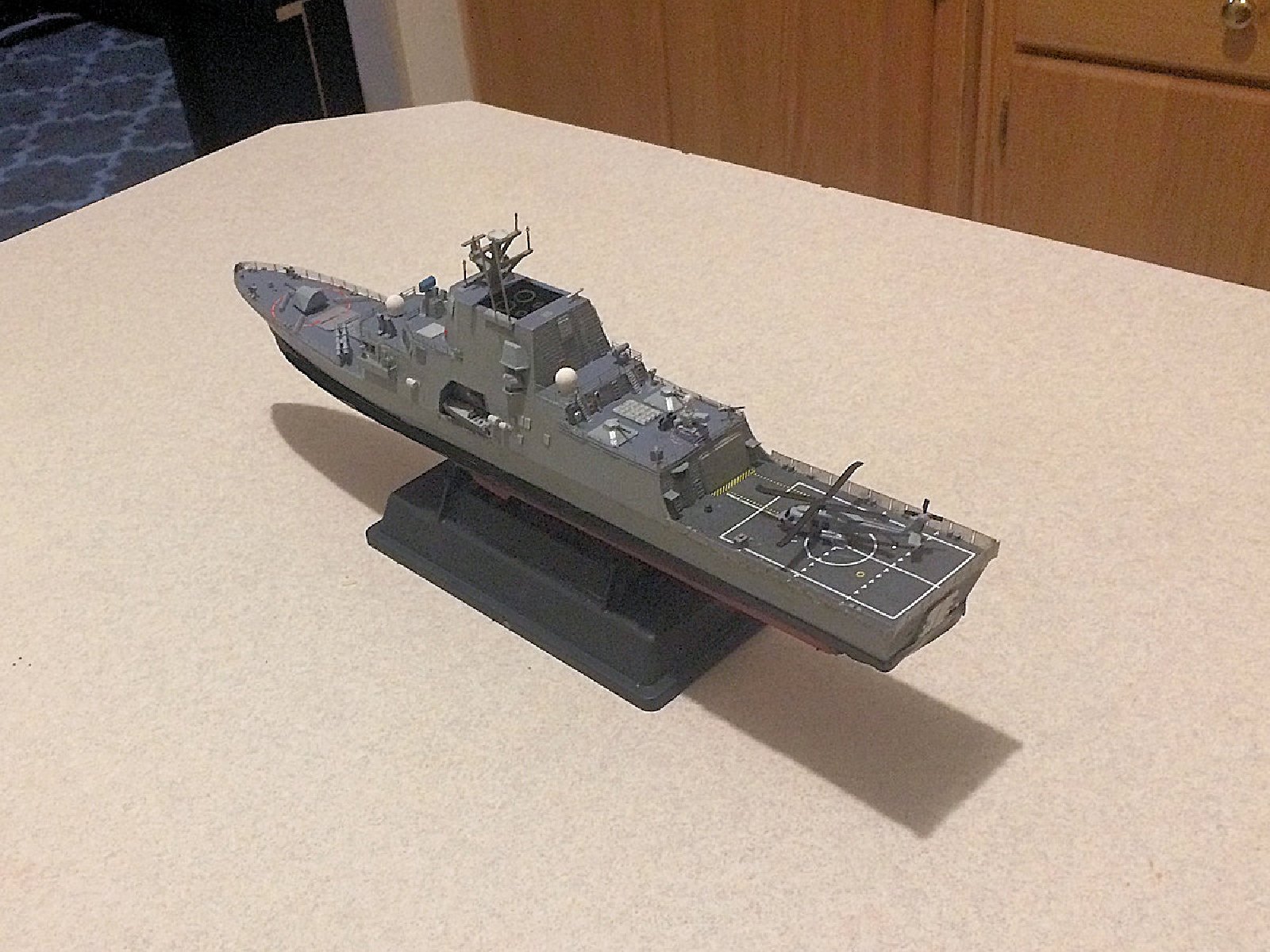
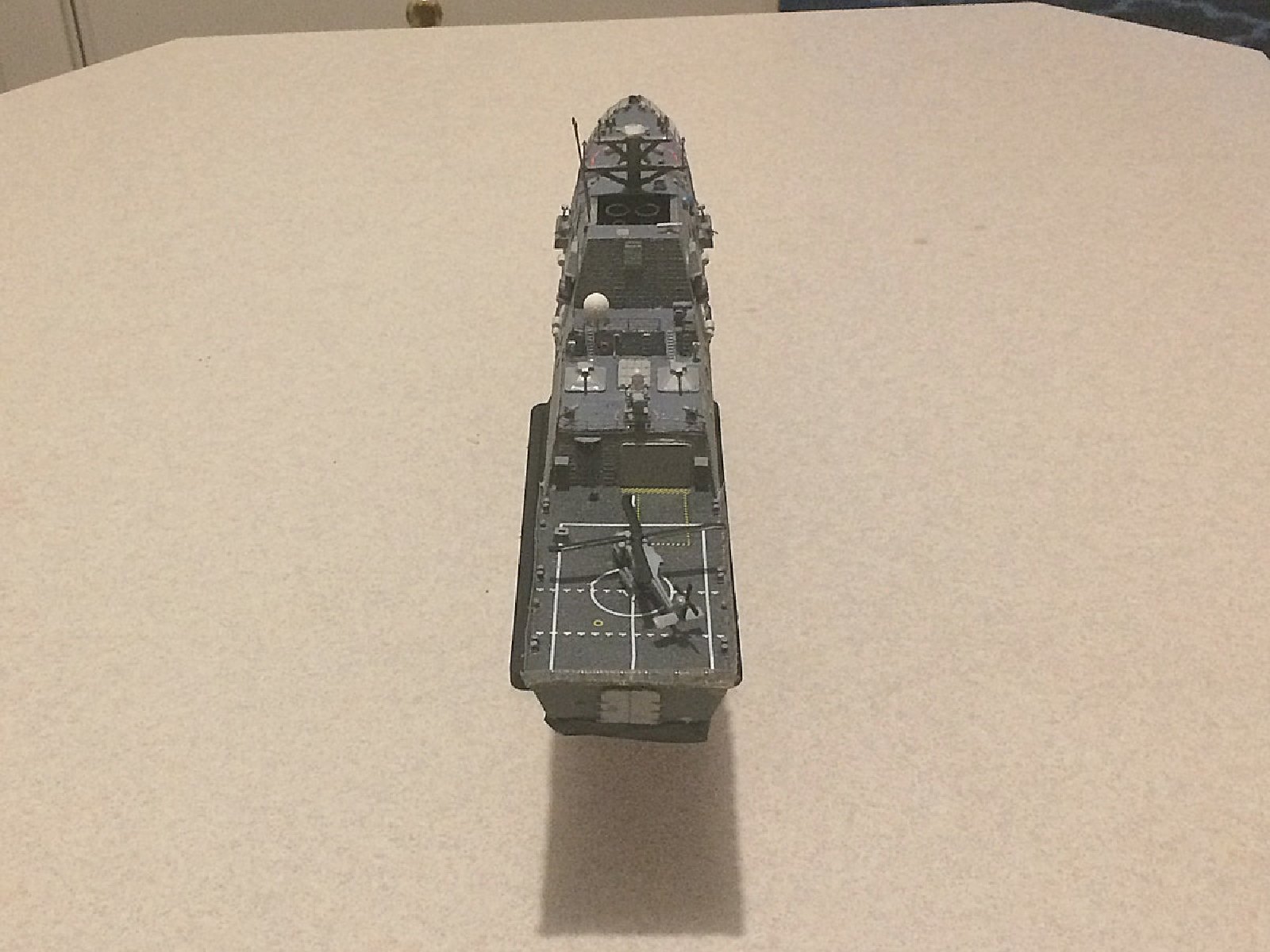
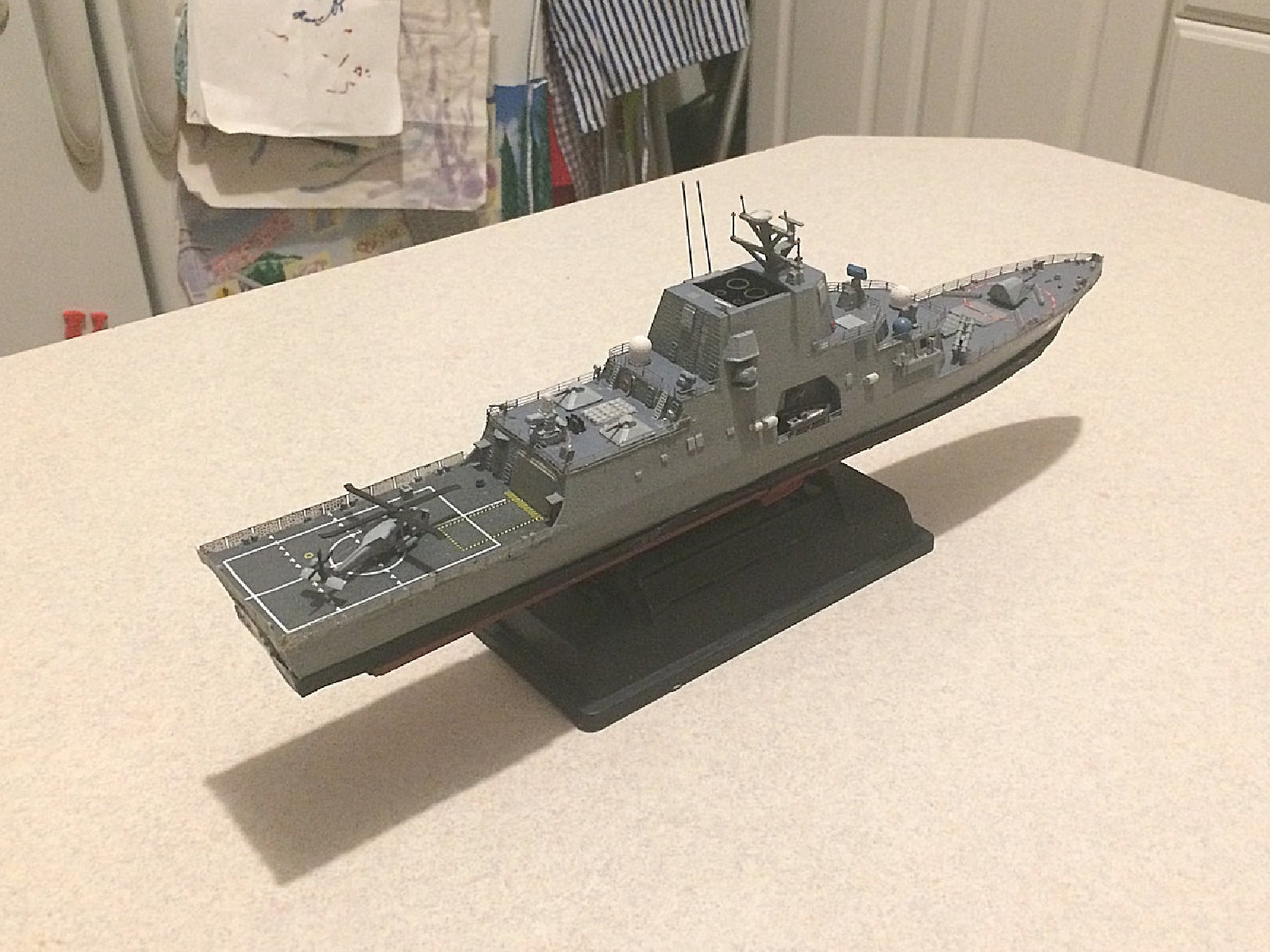
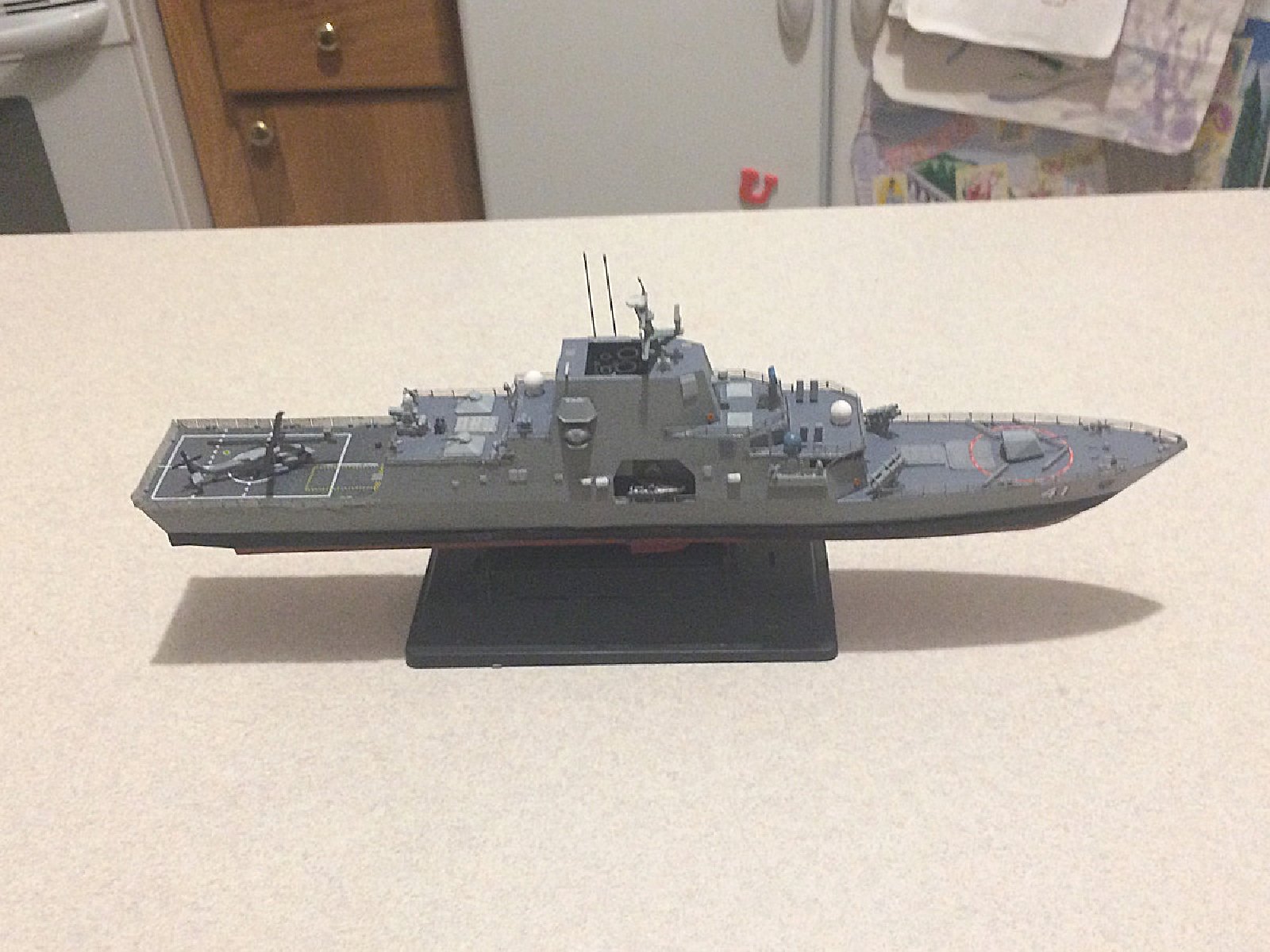
...and now those close up pictures:
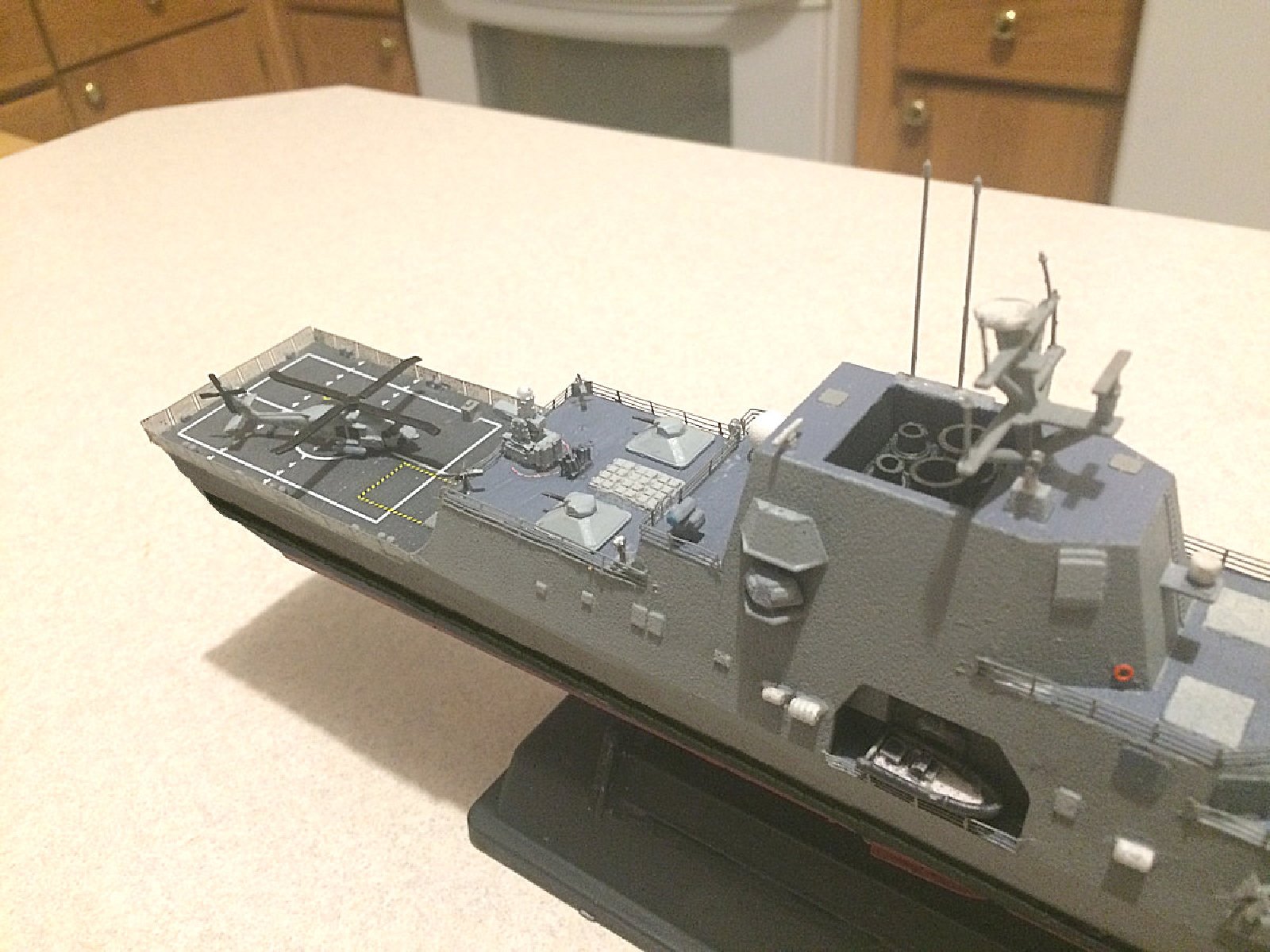
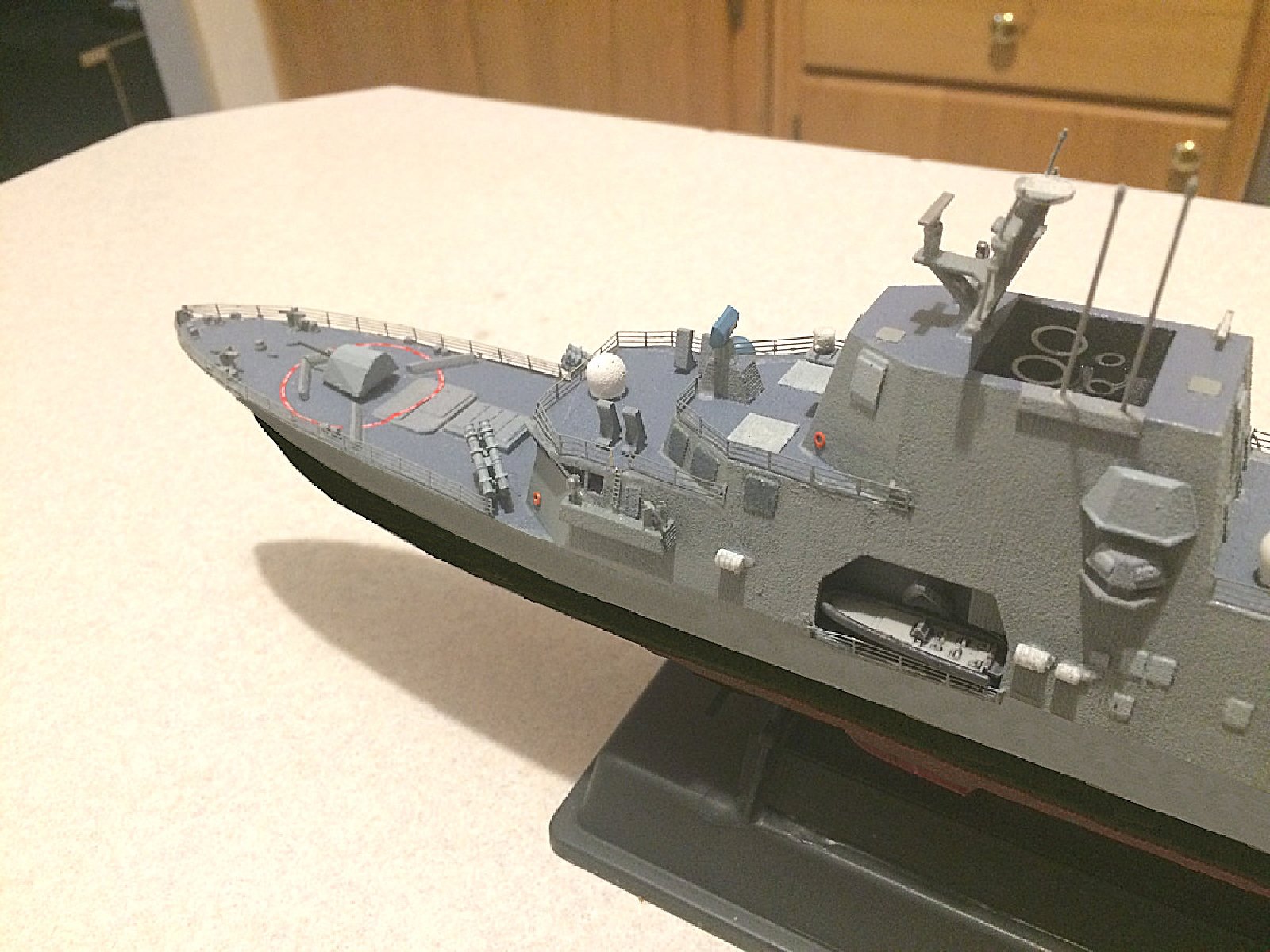
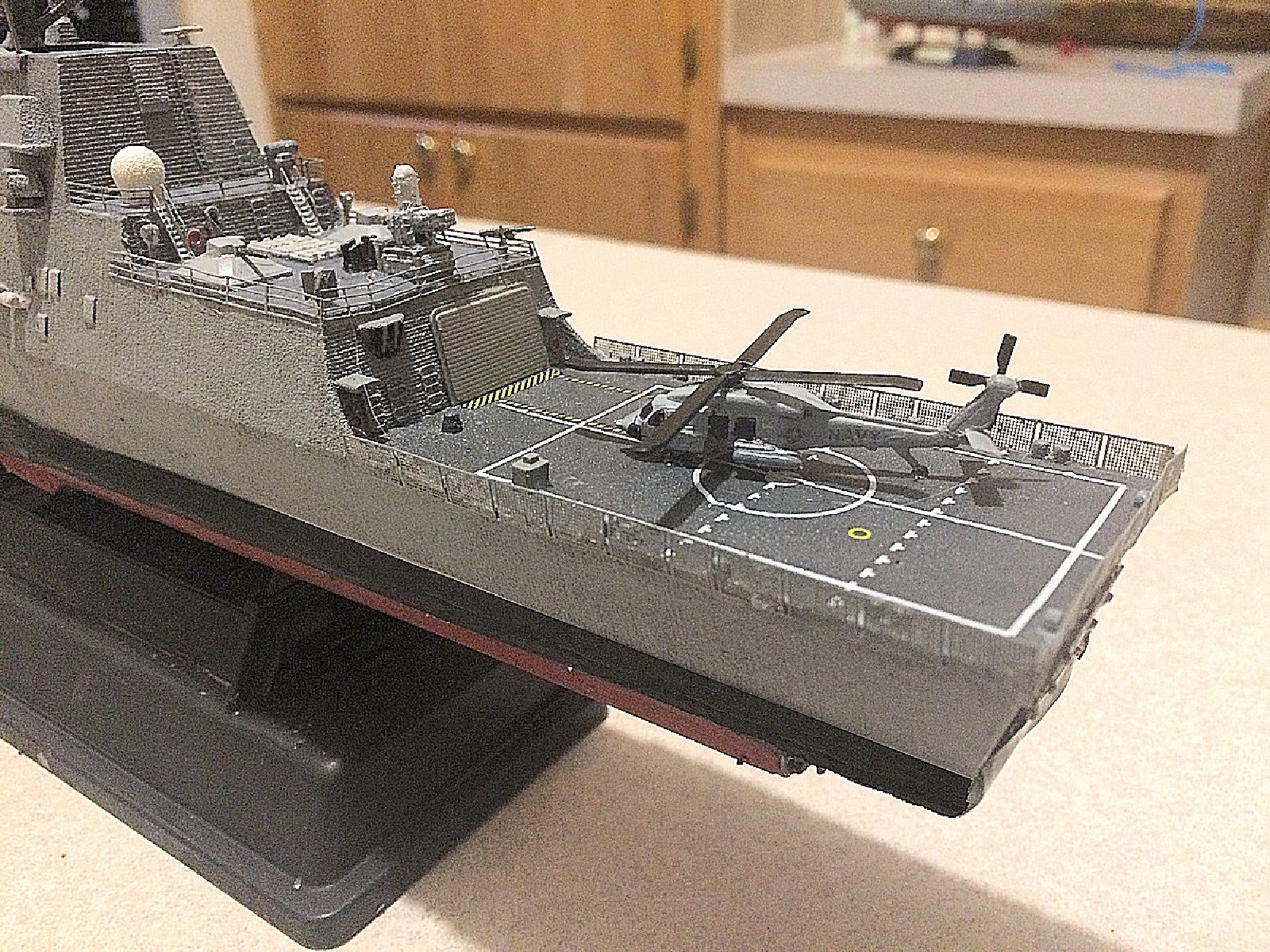
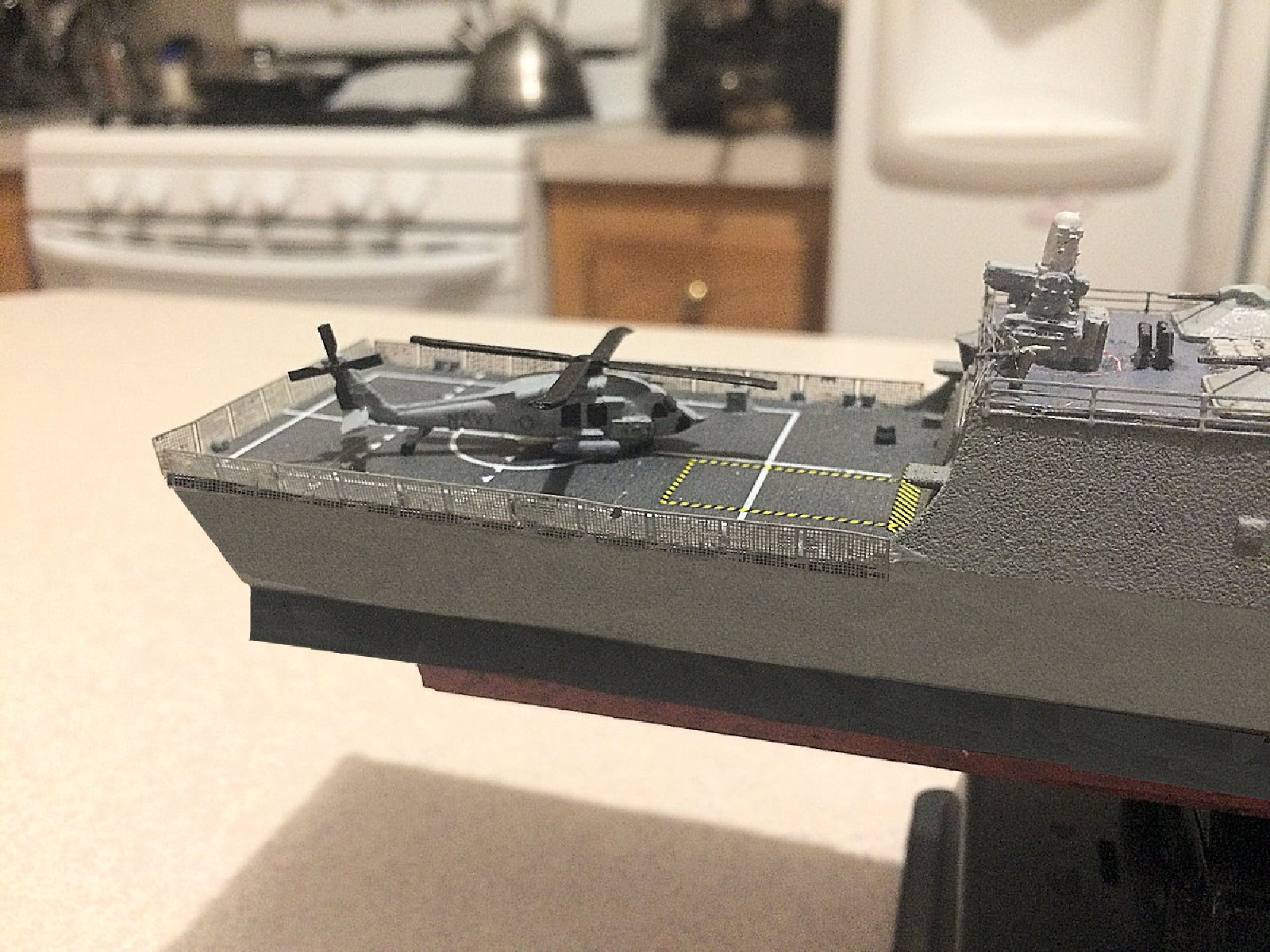
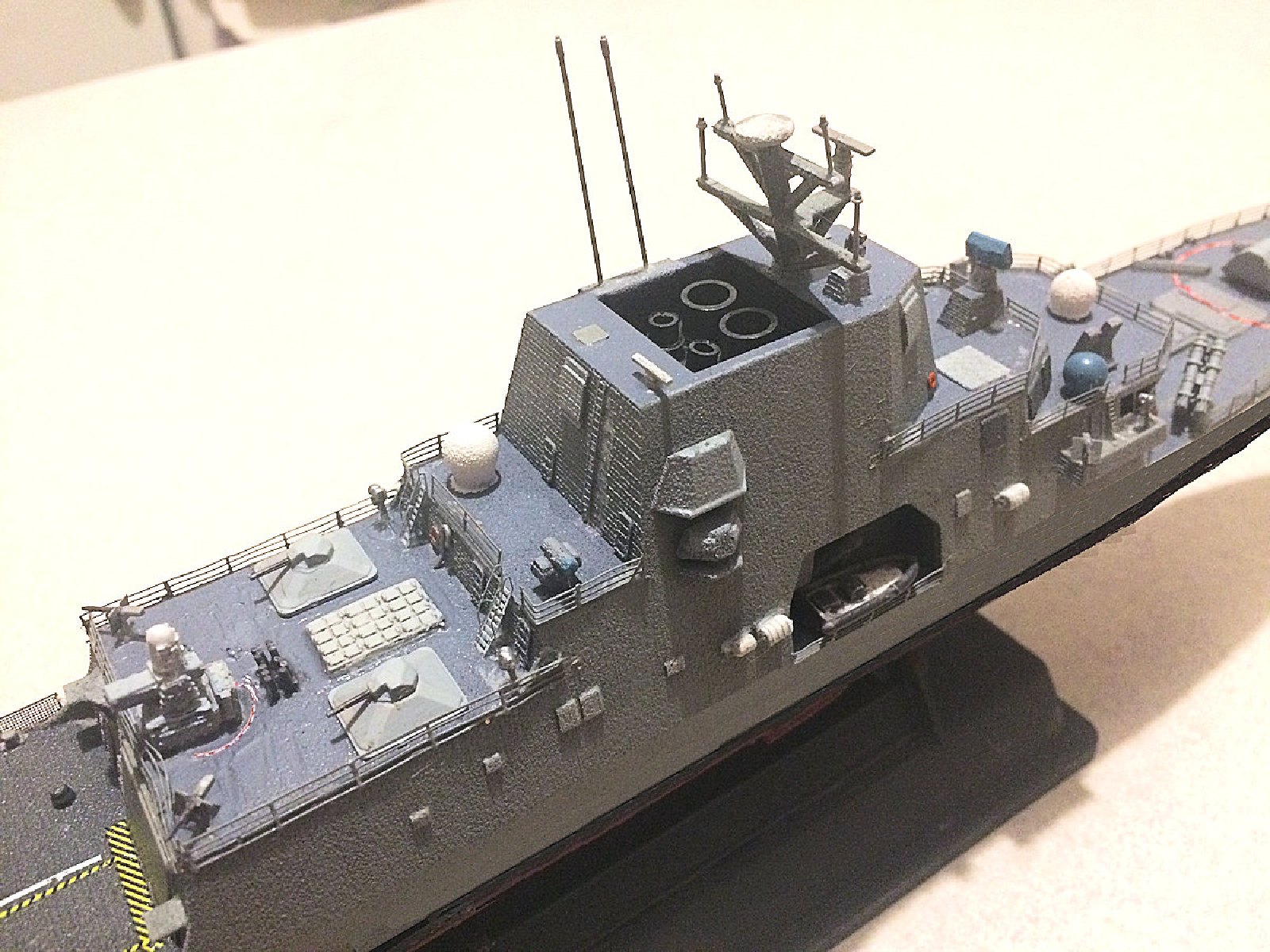
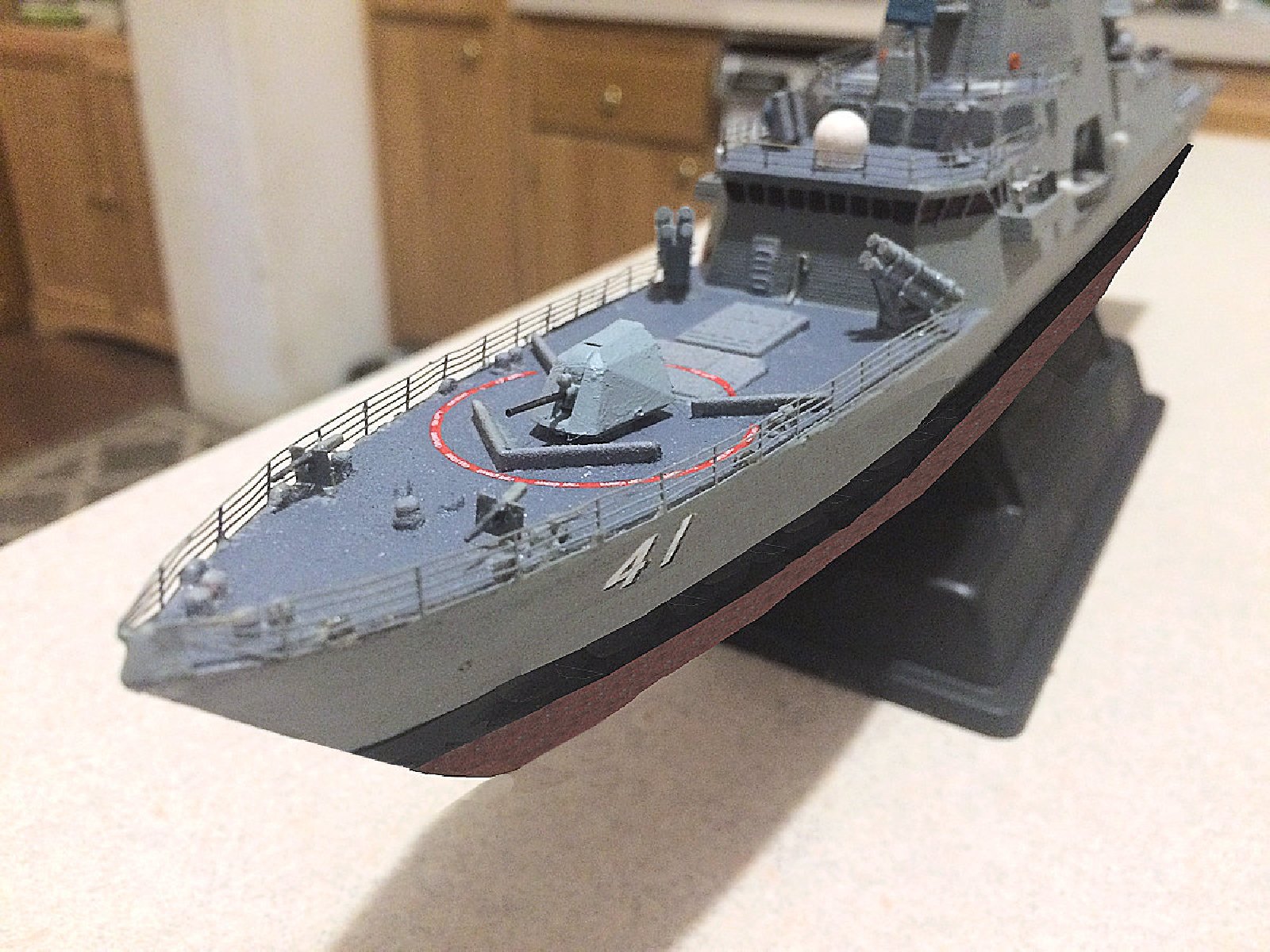
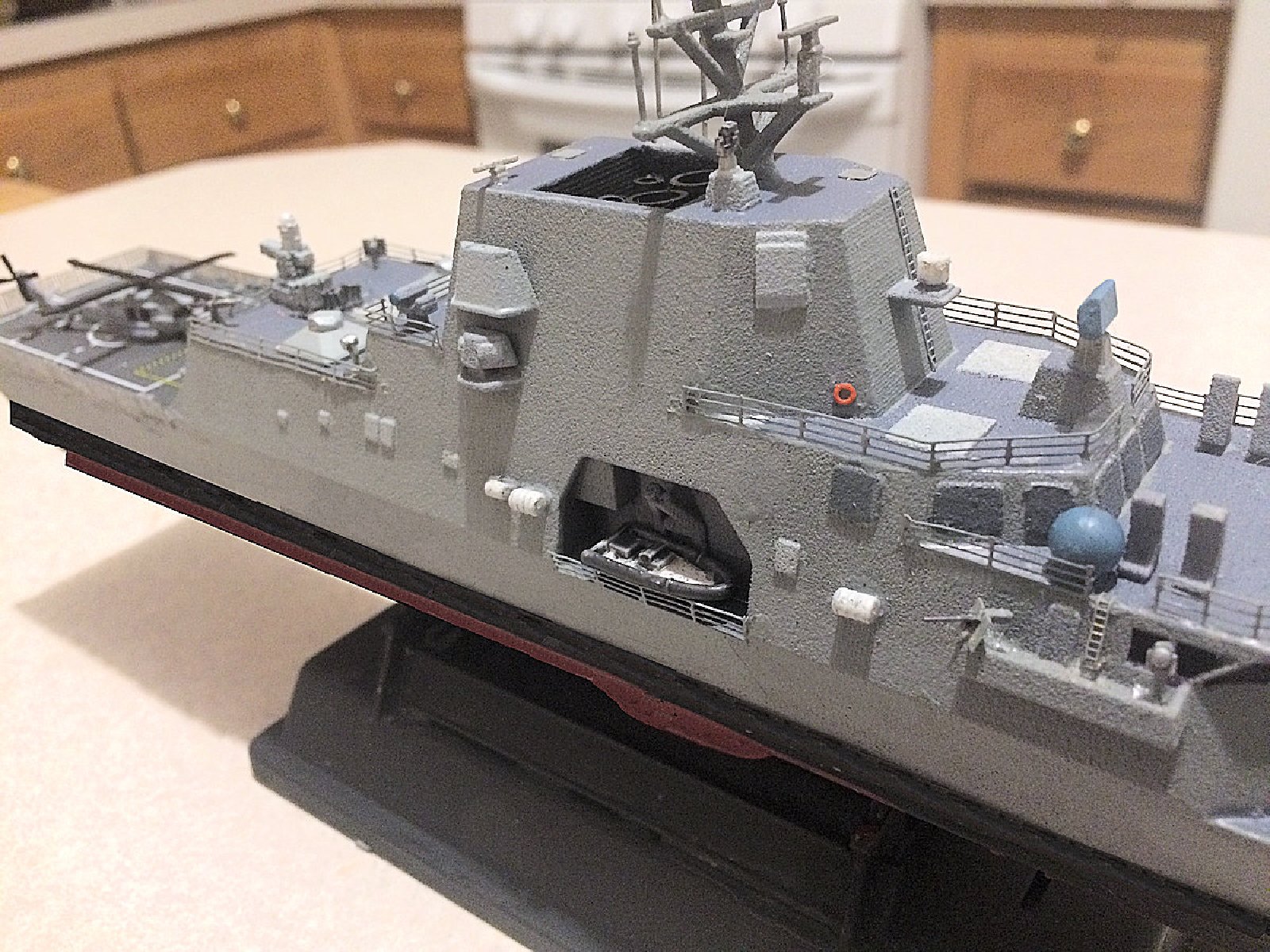
...and now the pictures comparing the FFG(C), which I gave the pennant number 41 o, to the USS Ft. Worth, LCS-3, showing her as an upgraded vessel to the FF standard with the extra weapons and sensors, making her FF-3:
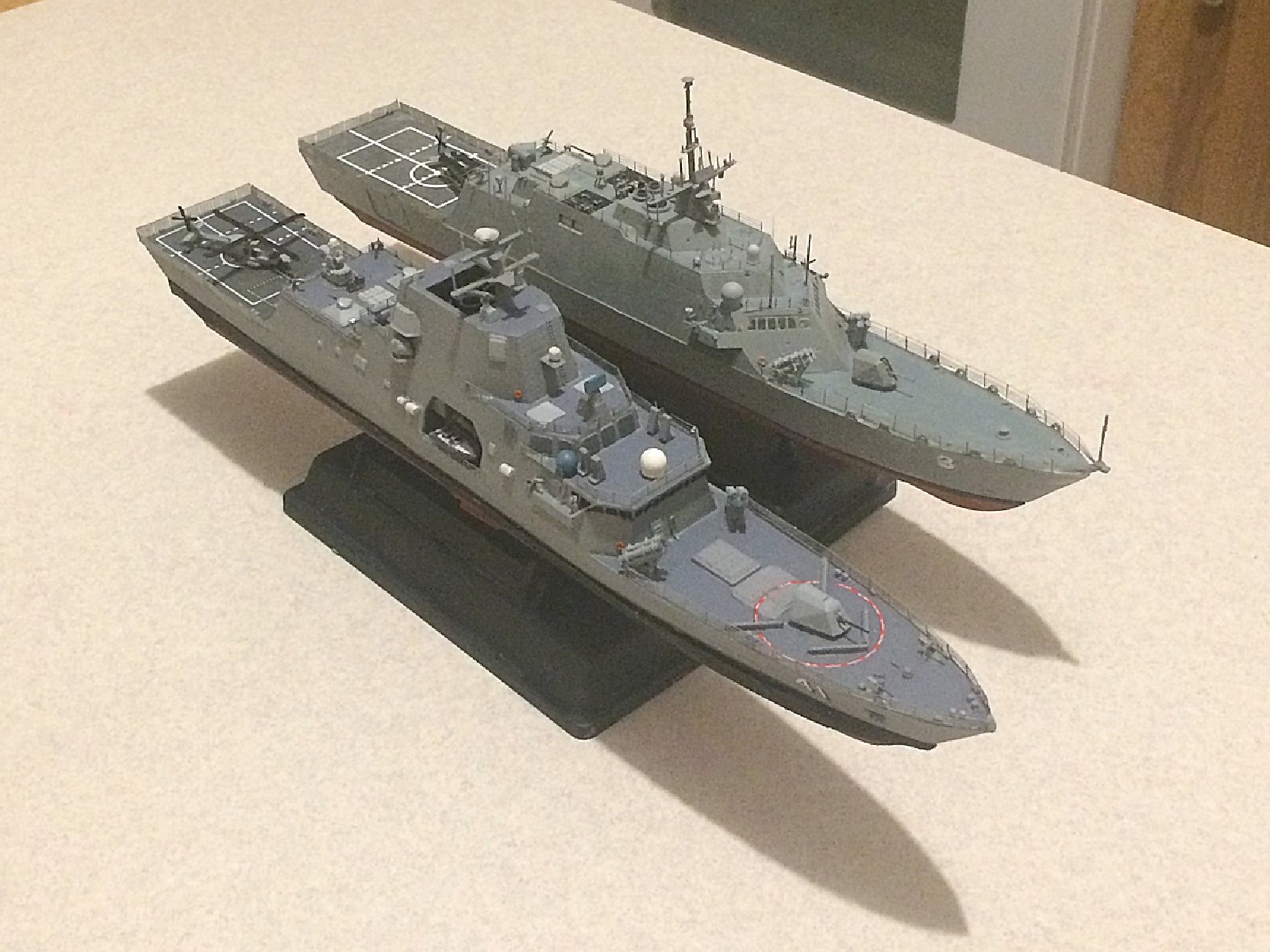
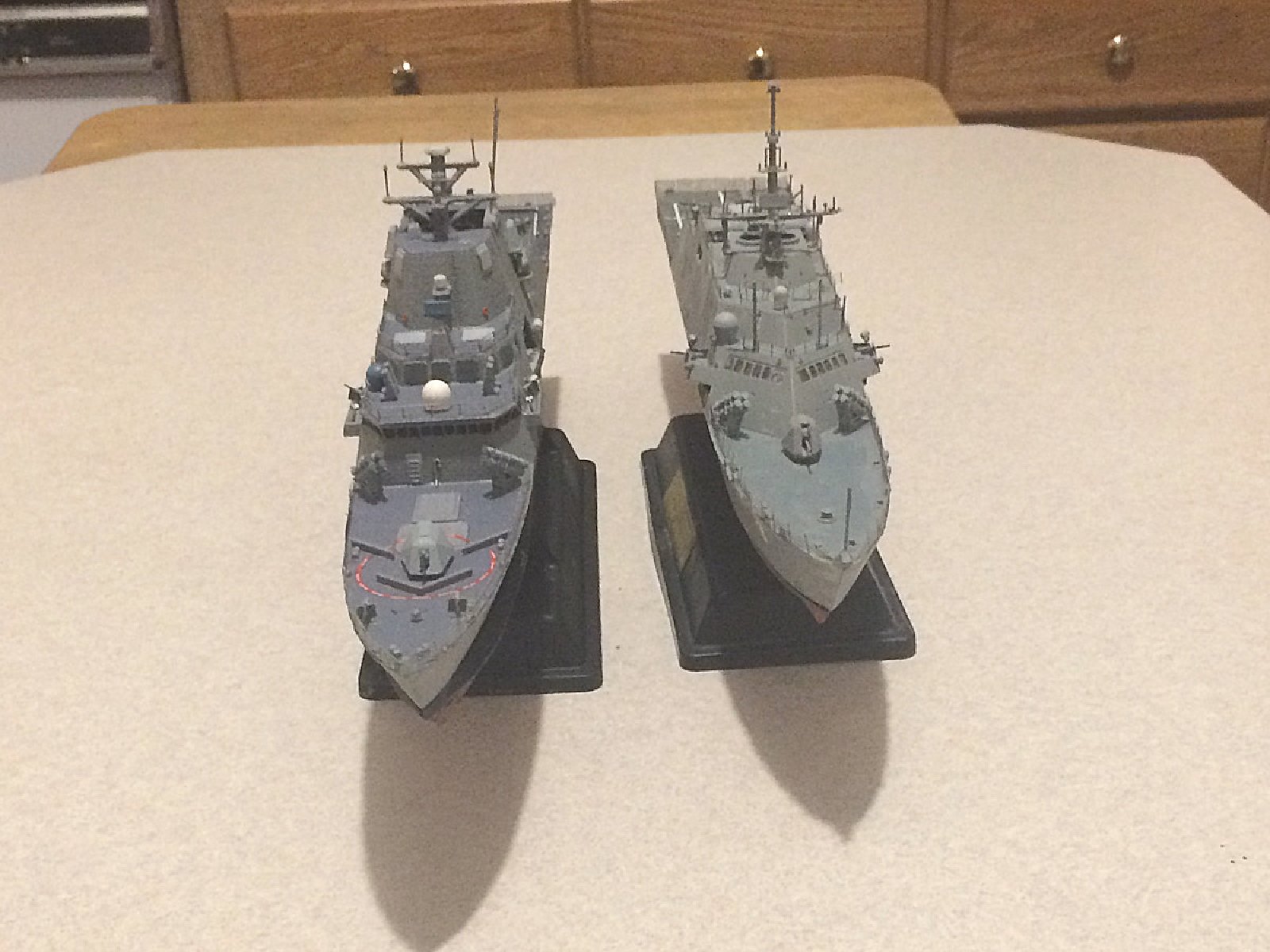
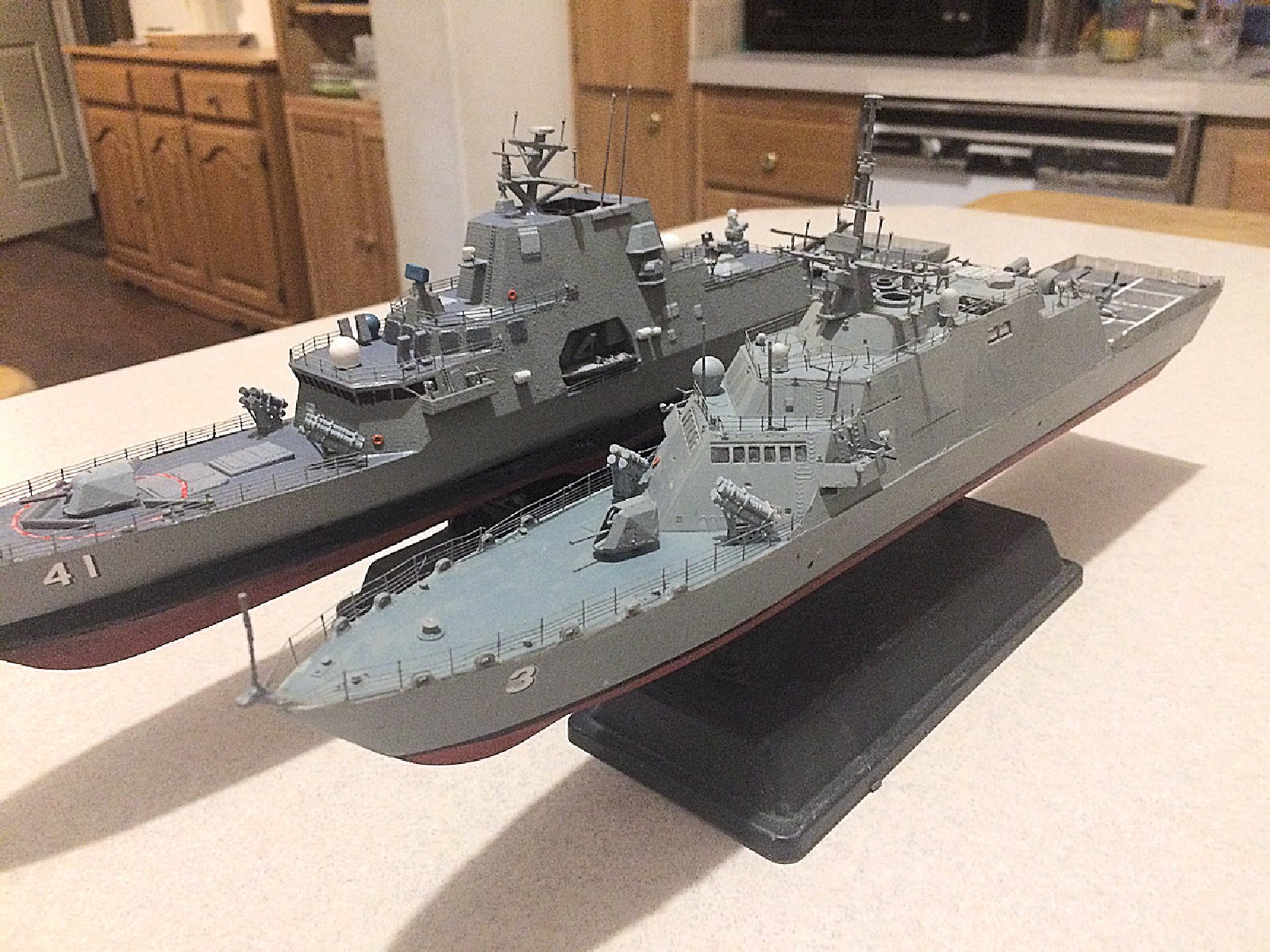
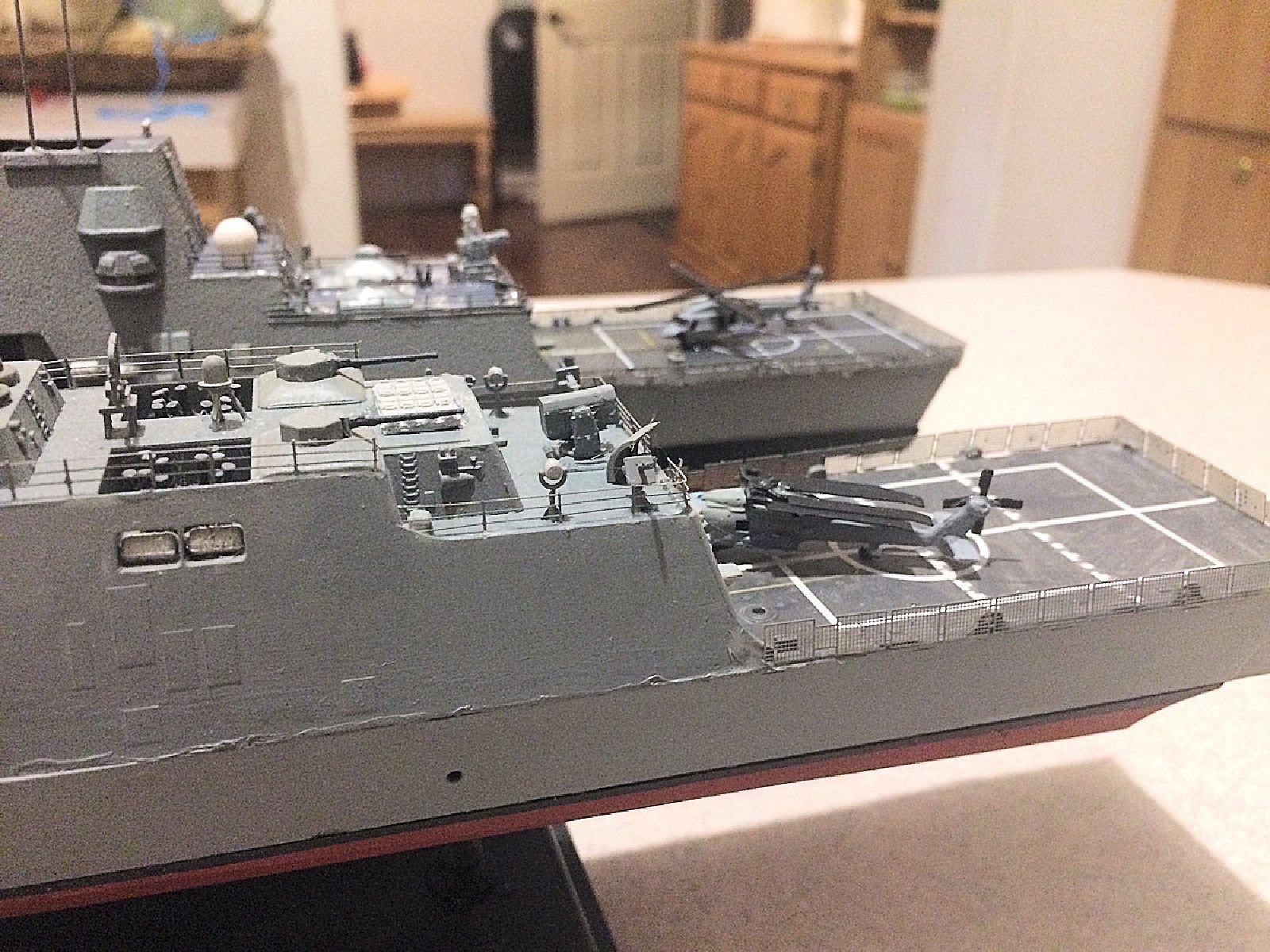
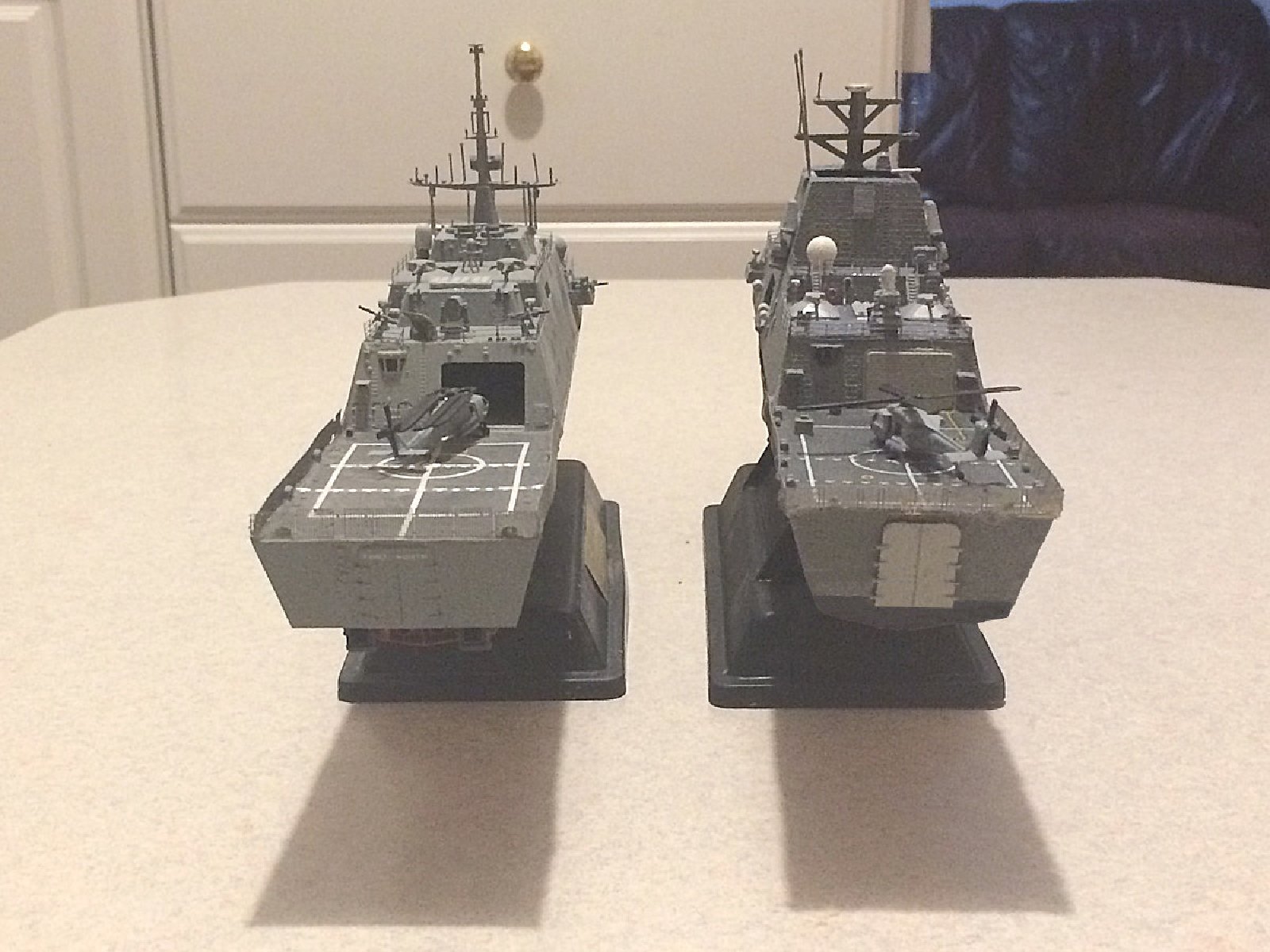
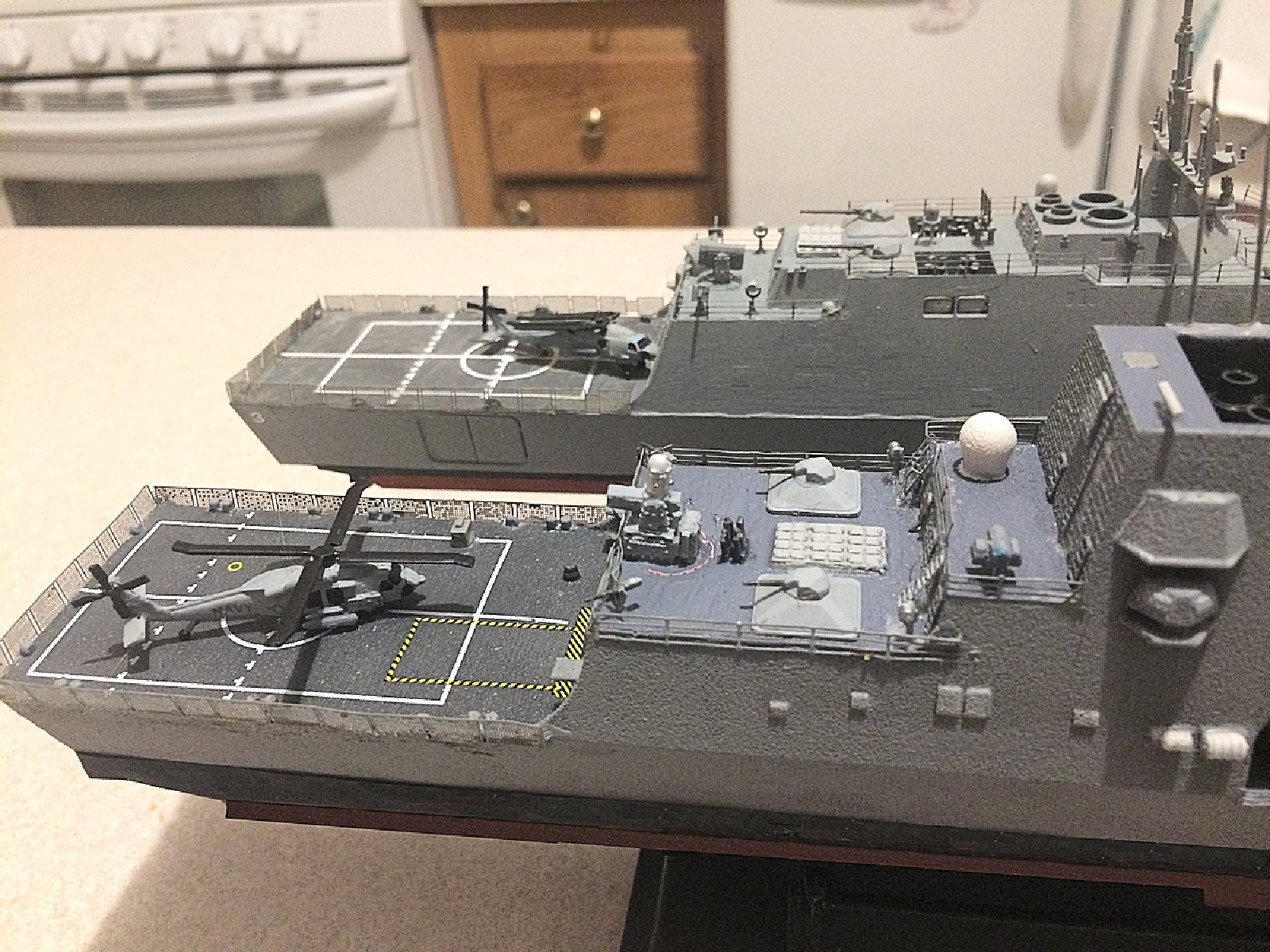
There you have it. A 1/350 scale model of the first FFG(X) new guided missile frigtae of the US Navy, assuming the Lockheed design is shown, and starting building sometime in 2020.
Hope you enjoyed it and please look at my other model builds on Fine Scale Modeler, and the many videos I have of them on my Youtube channel. Here are a few of the youtube channel videos:
US Navy two carrier Strike group in 1/350 scale:
www.youtube.com/watch?v=2EfoVwP4Kp0
US Navy Amphibious Ready Group in 1/350 scale:
www.youtube.com/watch?v=fs0pJvCq7eg
US Navy USS Ronald Reagan, CVN-76, Nimitz class carrier in 1/350 scale:
www.youtube.com/watch?v=ESlQidhdXT0
US Navy USS Enterprise, CVN-80 Ford class carrier in 1/350 scale:
www.youtube.com/watch?v=q04Hy8CQjC8